50 years of NDP: The parade through the years
The National Day Parade was conceived to wow spectators, a feat it has continued to achieve after 50 years.
Sign up now: Get ST's newsletters delivered to your inbox
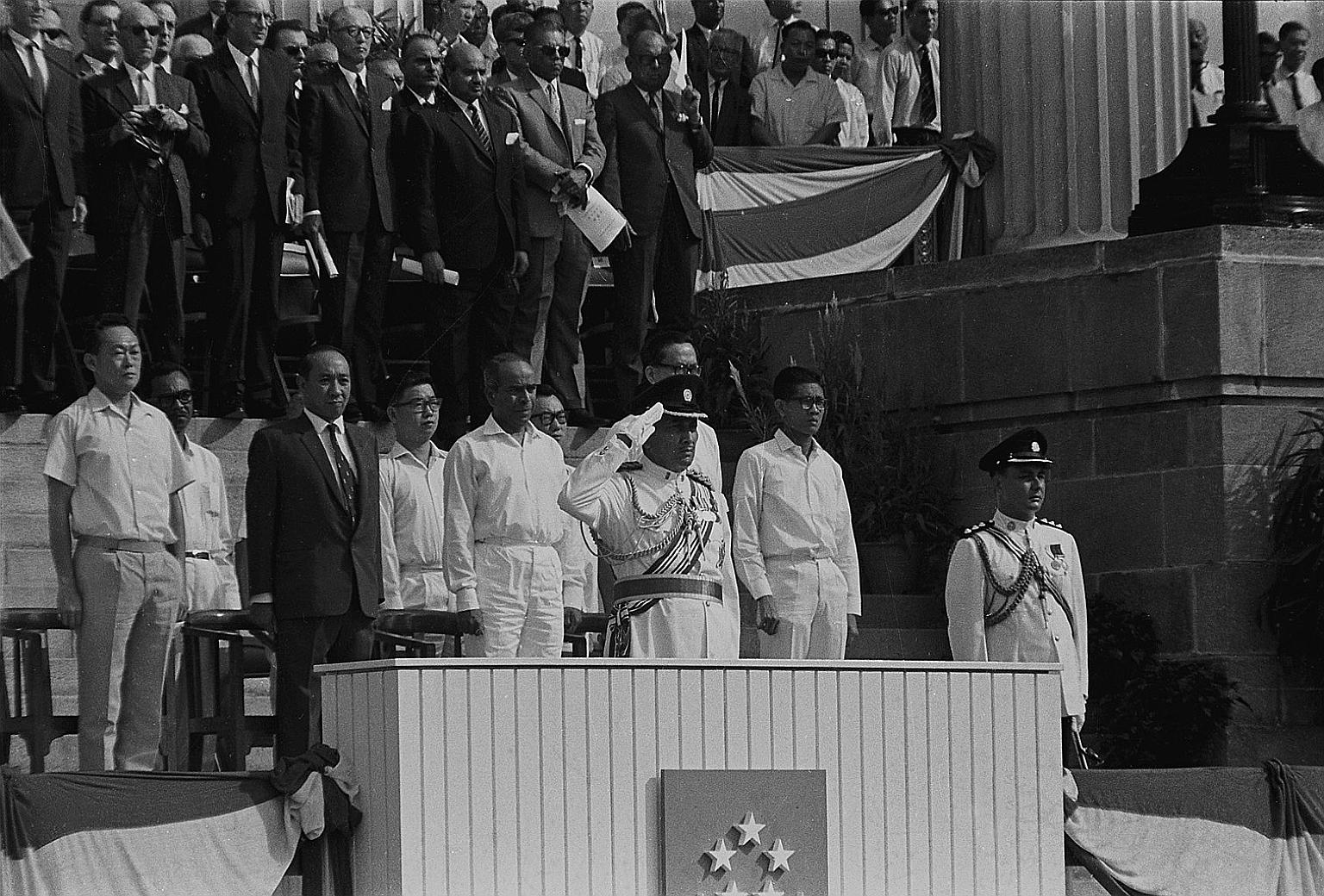
1966: Singapore's first National Day Parade kicks off at 9am at the Padang. President Yusof Ishak, resplendent in military uniform, takes the salute, with PM Lee Kuan Yew and ministers behind him. The parade features 23,000 participants and a military parade that marches through Chinatown. According to an interview from the National Archives, a seven-man committee helmed the event.
Follow topic:
1966
Singapore's first National Day Parade kicks off at 9am at the Padang. President Yusof Ishak, resplendent in military uniform, takes the salute, with PM Lee Kuan Yew and ministers behind him. The parade features 23,000 participants and a military parade that marches through Chinatown. According to an interview from the National Archives, a seven-man committee helmed the event.
1967
The second National Day Parade, also at the Padang, sees an increase in the participation of women, with 36 female bagpipers a main draw. The women - young office workers, teachers and students - had less than five months of training. The day also features the "longest and loudest bang" in Singapore's history - firecrackers are set off for 15 minutes by the Chinese Chamber of Commerce.
1968
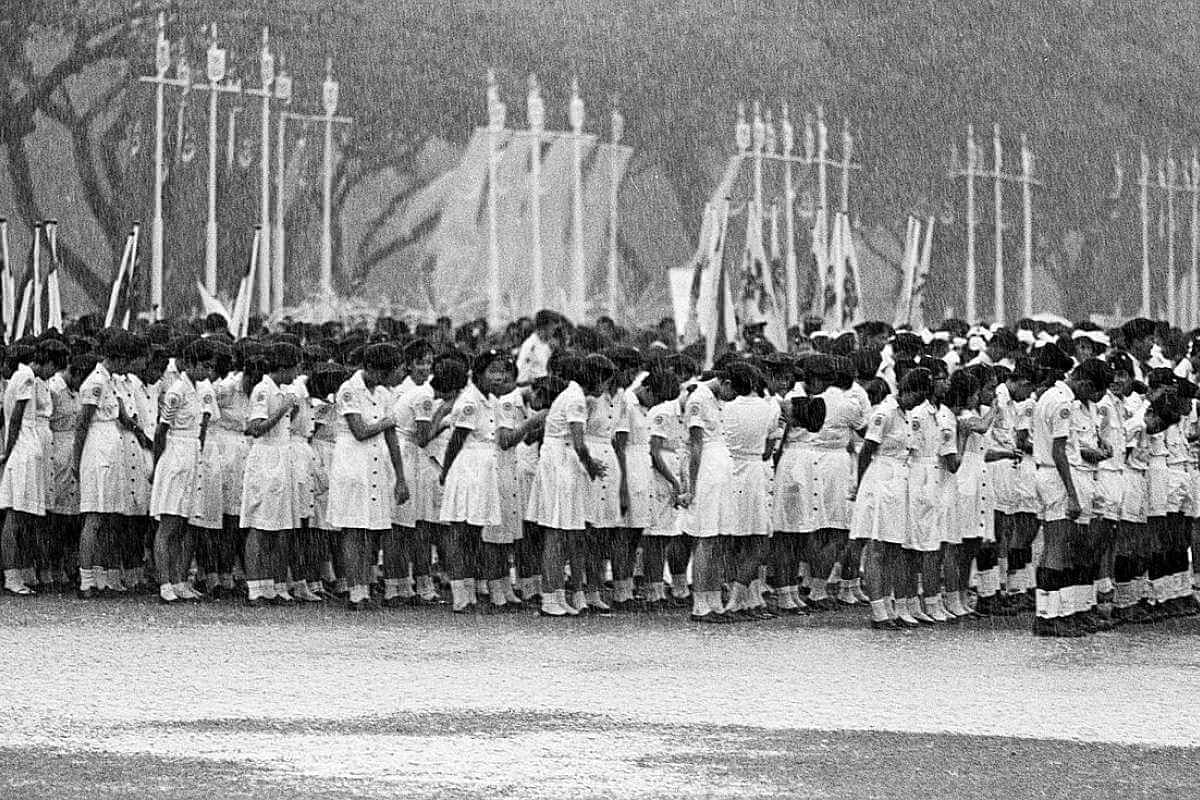
Bedraggled contingents stand stoically throughout an unexpected downpour. MPs, the Cabinet and PM Lee Kuan Yew also take seats in the rain at the Padang. Mr Lee says later that he was worried about the children and asked how many had fallen ill the next day. He says in 1988 that this was his most memorable parade.
1969
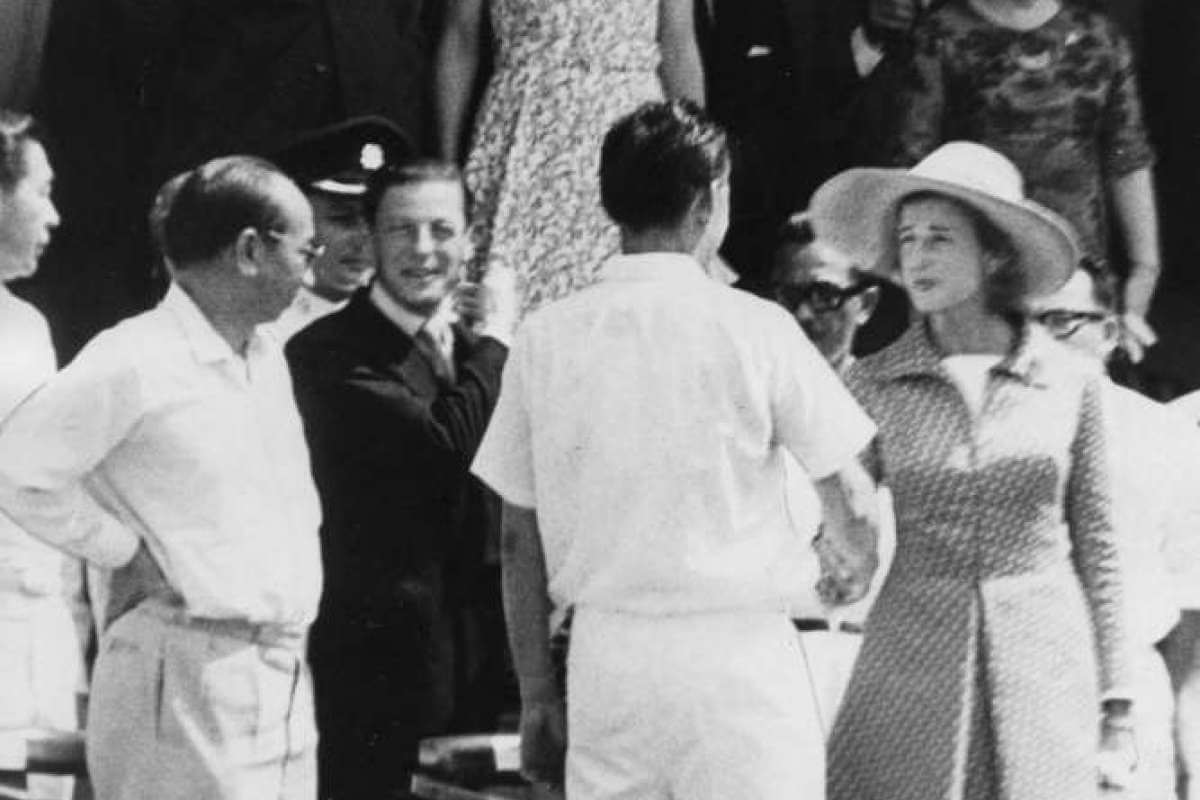
With foreign guests - Queen Elizabeth's cousin Princess Alexandra, Malaysian Deputy Prime Minister Abdul Razak, and representatives from New Zealand, Britain and Australia - in the stands, this parade sets out to impress.
The stars of the show from Singapore's armoury - 18 tanks, 16 unimogs with 120mm mortars and 32 jeep-mounted recoilless guns.

PM Lee Kuan Yew greeting the princess after the parade, while Finance Minister Goh Keng Swee chats with her husband, Mr Angus Ogilvy.
1970
Jets make their debut, with nine BAC Strikemaster jet-trainers and Alouette III helicopters flying low over the Padang. Participants and guests are asked to tune in to the radio at 5am to find out if there would be a likelihood of rain, in which case the parade would have to be postponed. This parade also features the first fly-past of the state flag, which would become an annual highlight.
1971
This is President Benjamin Sheares' first National Day Parade as head of state. The parade finale has a "blue-collar" theme, focusing on industrialisation and the importance of blue-collar workers.
1972
Floats are the highlight of this parade, with the People's Association presenting six of the 10 floats. Progress and multiculturalism are the main themes.
1973
For the first time, the parade is held in the evening. Another first is a contingent of police and army dogs - 50 labradors and alsatians march on-leash.
SAF dogs and their handlers at the parade.
1974
The parade is seen on TV in colour for the first time, with colourful floats taking centre stage. It also features the biggest fly-past so far, involving 56 aircraft from the Singapore Air Defence Command. The parade ends with a spectacular fireworks display over the harbour.
1975
On Singapore's 10th birthday, the parade breaks out into "pocket pageants", with celebrations taking place at 13 locations around the island for the first time.
Bicycle acrobats entertaining the crowds at the Maxwell Road centre.
1976
The parade is held at the National Stadium for the first time, with some 60,000 Singaporeans packed into the parade site. Contingents also march a 6km route from the stadium through streets lined with thousands of people. Singapore Airlines' 21m replica of a jumbo jet - with 36 stewardesses perched atop it - is reportedly the most attractive float.
1977
Celebrations are held at six decentralised locations - Jurong, Toa Payoh, Tiong Bahru, Jalan Besar, Bedok and Queenstown. However, the centres are reportedly overwhelmed by crowds.
1978
The big parade returns to the Padang. The first troupe of women lion dancers participate in the largest lion and dragon dance performance which comprises 140 lions and nine dragons.
1979
The parade, at six locations in the heartland, is ticketed for the first time to manage crowds that had overwhelmed the 1977 celebrations.
1980

Back at the National Stadium with a crowd of 100,000, the parade is bigger than ever before. It is captured on TV from the air for the first time and is President Benjamin Sheares' last parade as head of state.
1981
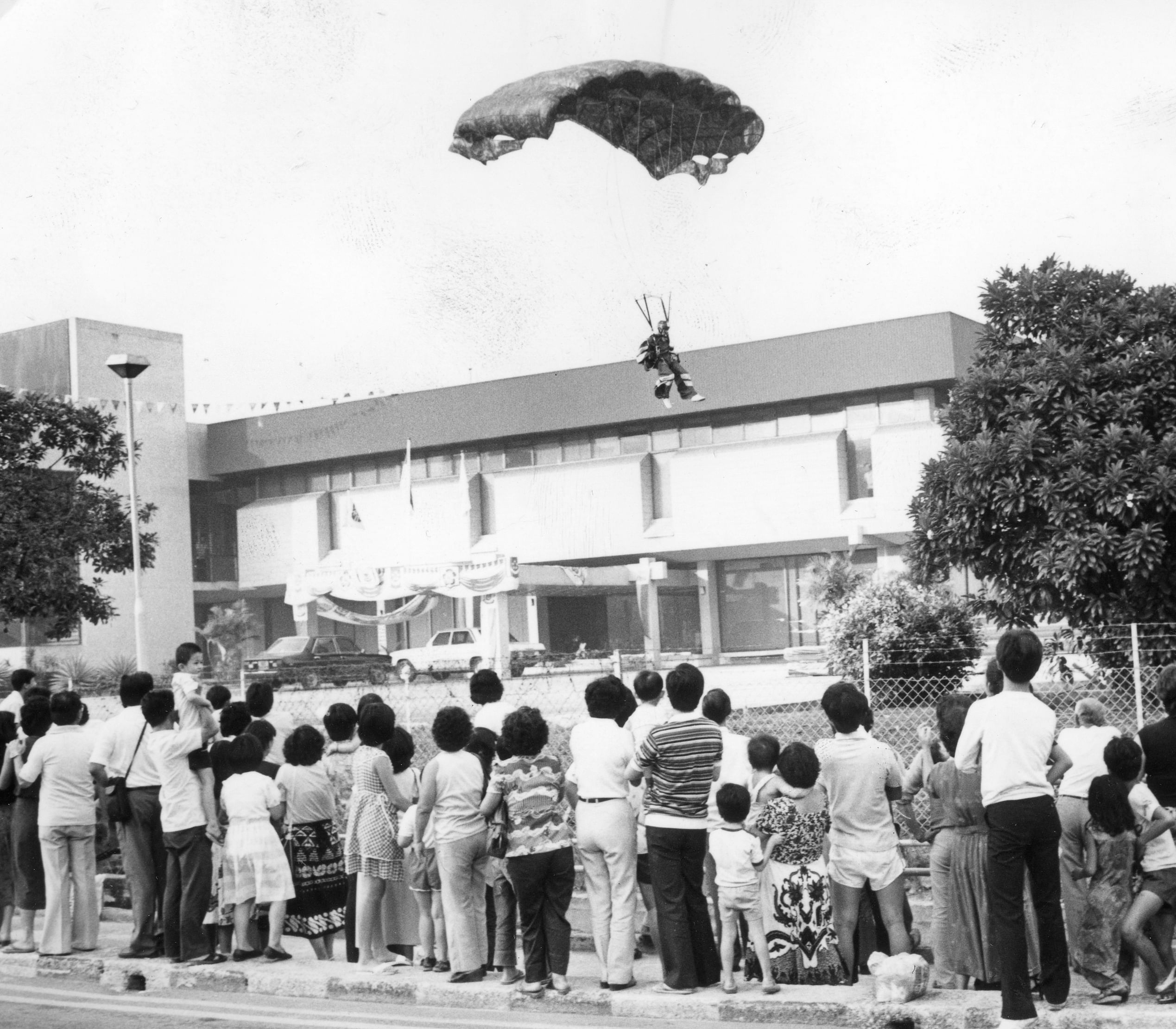
Decentralised celebrations are held at six locations, with some drama reported: At Ang Mo Kio Secondary School, a platform for VIPs collapses under their weight half an hour before the parade begins, and a policeman draws his revolver to break up a fight between members of two dragon dance troupes; in Toa Payoh, a commando skydiver deploys his emergency parachute when the main one fails and two other skydivers land off target - to applause nonetheless - at an electronics factory50mfrom the stadium.
1982
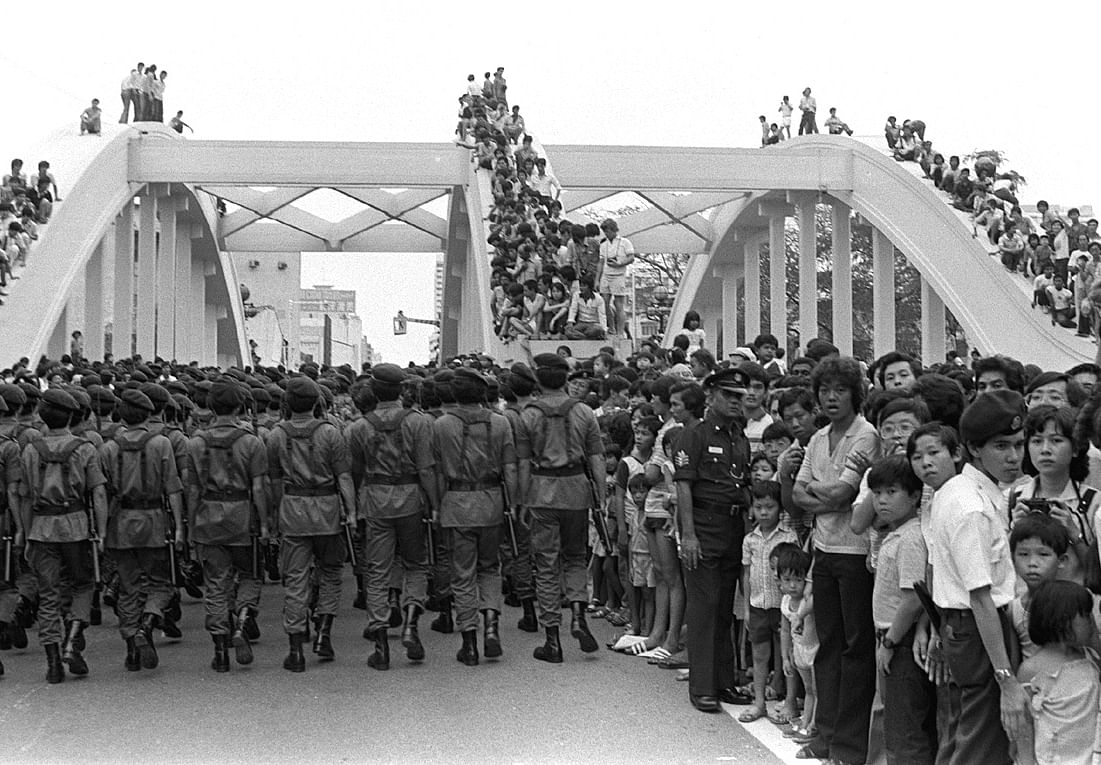
This marks President Devan Nair's first parade as head of state. The parade is back at the Padang, but the highlight is a display of 1,800 fireworks which are set off near East Coast Parkway. While only 21,000 attend the parade proper, the crowds lining the streets are said to be the largest in 12 years.
1983
This is Singapore's last decentralised parade. One commando, aiming to land at Toa Payoh Stadium, ends up in Whampoa when his parachute fails to deploy in Toa Payoh and he has to use his emergency chute.
1984
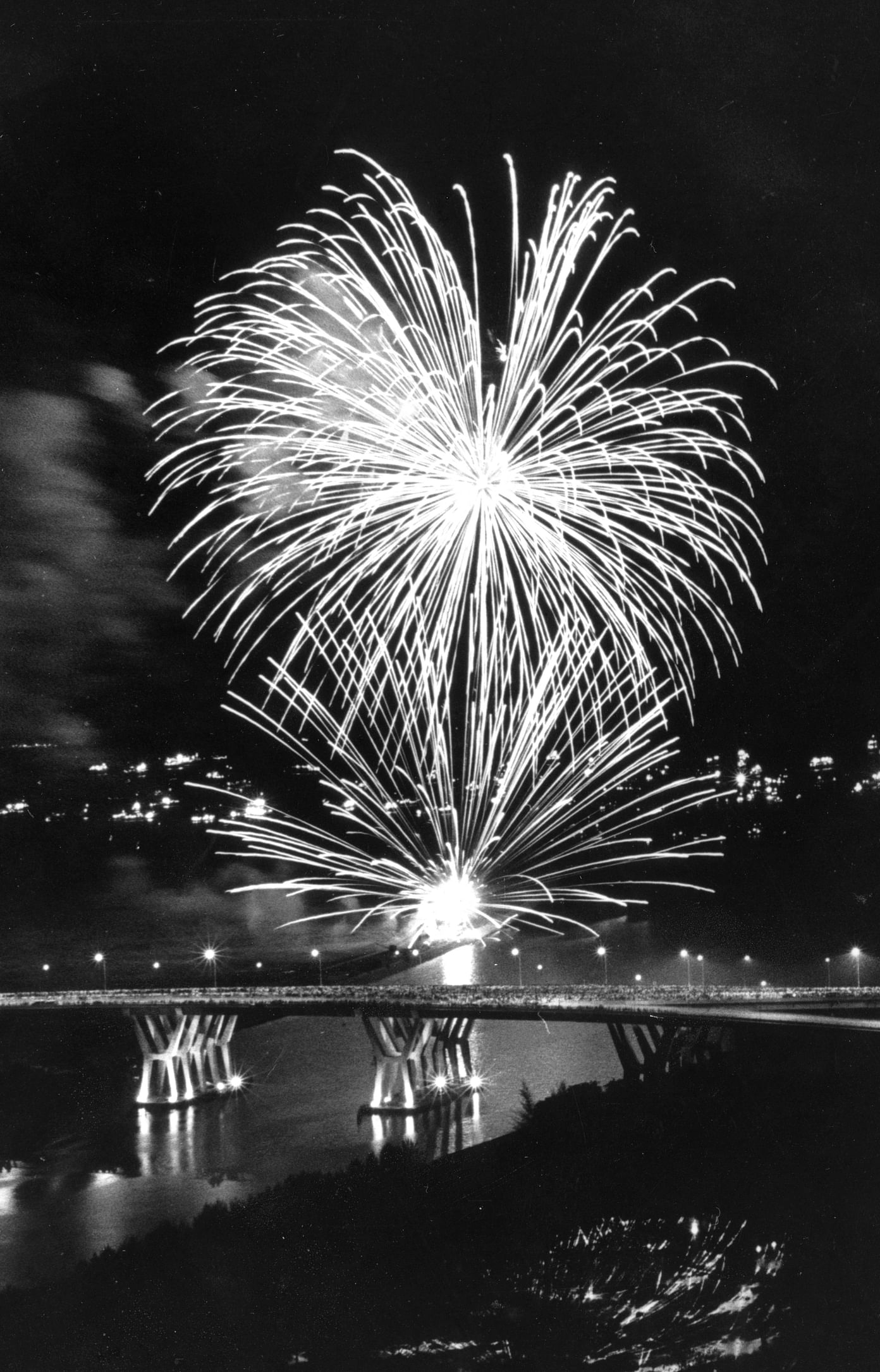
The famous Stand Up For Singapore is first sung at this parade. A grand military column of 116 vehicles trundles from City Hall to Serangoon Road.
1985
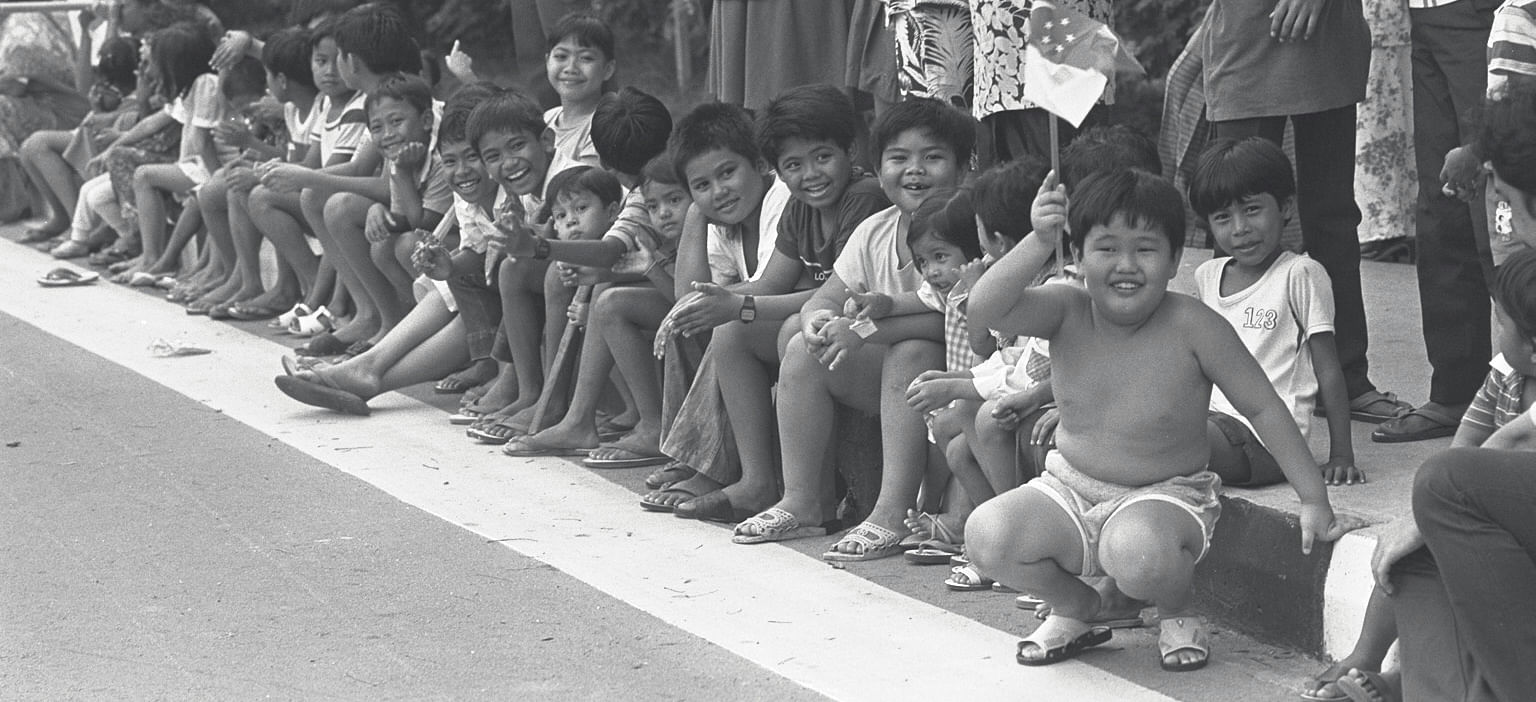
Despite news of a recession, about 60,000 spectators pack the National Stadium. Above: Children lining the street to catch the marching contingents at the full dress rehearsal.
1986
President Wee Kim Wee makes his first appearance as head of state. The year sees the introduction of the popular song Count On Me, Singapore, and marks many firsts: Never before has a parade started so late - 6pm; never before has a rock group been featured - Tokyo Square mimes hits before the parade. There are also no tanks this year.
1987
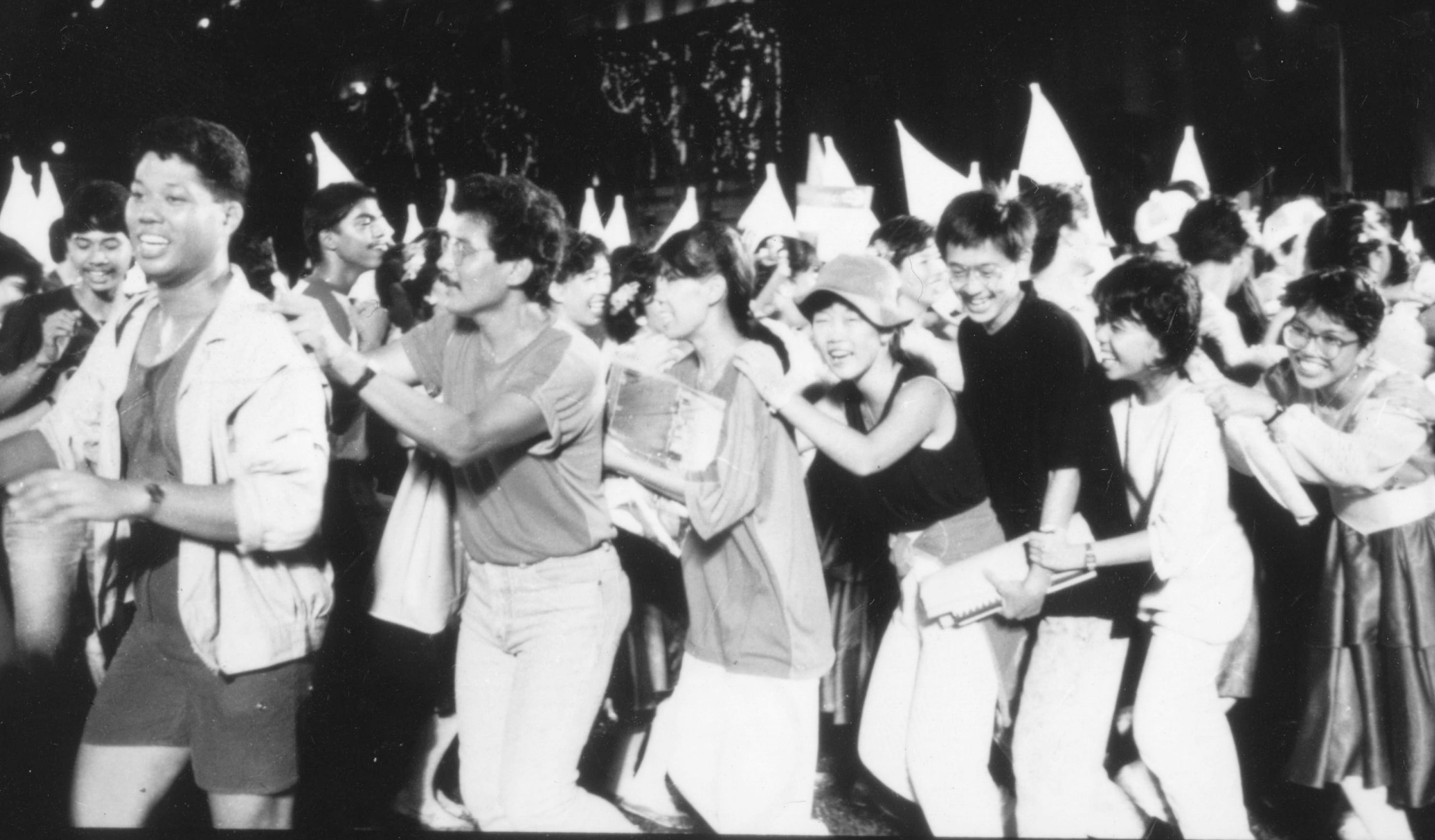
Another beloved tune -We Are Singapore - makes its debut. The year also sees a street party finale with people dancing and singing in the streets and at the Padang. About 100,000 lights are strung up around the Padang area and lit simultaneously, literally lighting up the night.
1988
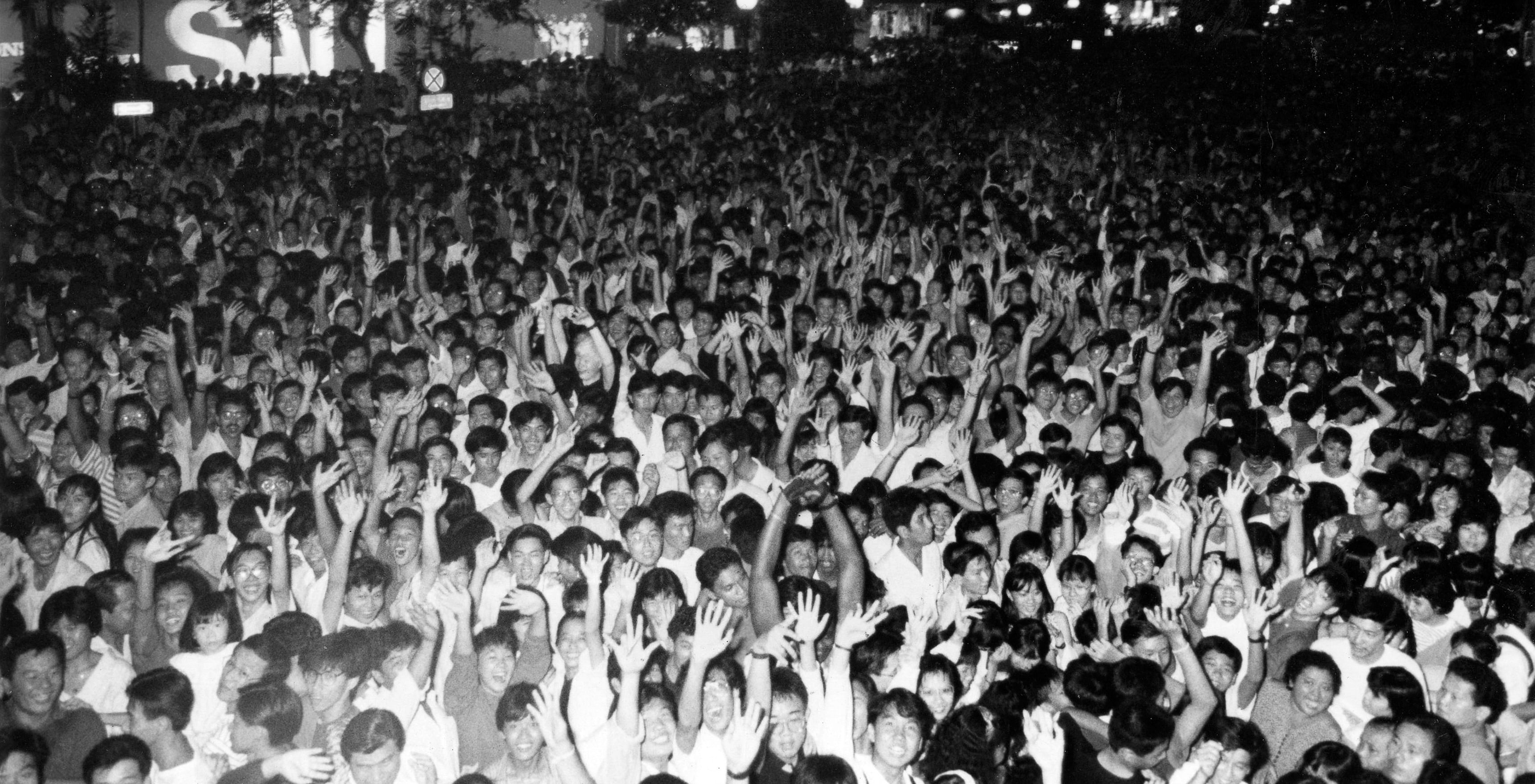
Swing Singapore, the first street party, is held on Aug 8 with about 100,000 people packing Orchard Road. Dancing is cancelled due to the unexpectedly large crowd, but Prime Minister Lee Kuan Yew says in the following days that it was a mistake to cut the party short. He suggests a second party and one is held at the end of the month with about 250,000 people showing up (above). It is planned in just 17 days.
1989
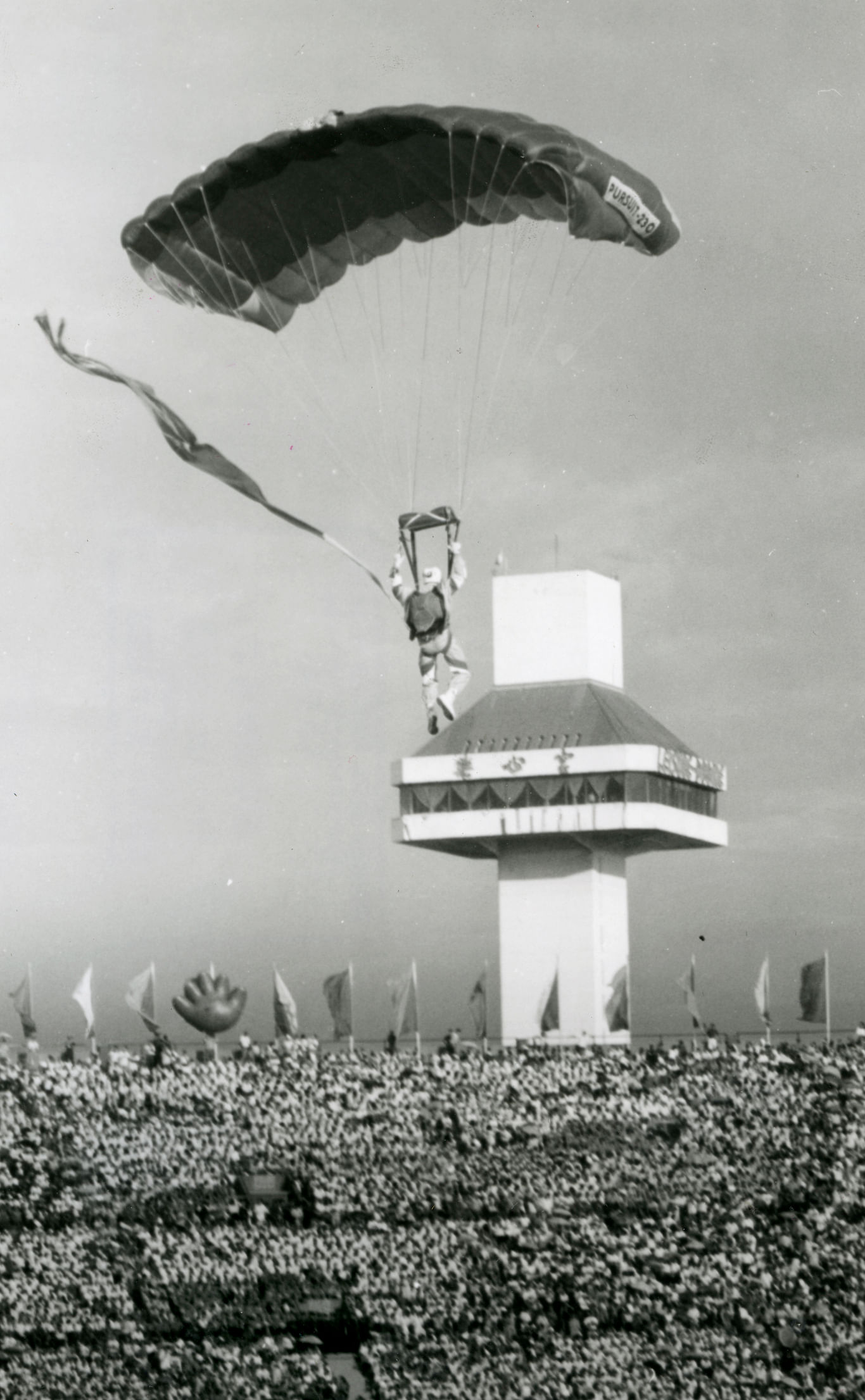
This year's parade is remembered for the first daytime fireworks - 20 smoke strings forming the shapes of flowers, palms and willows. They are kept under wraps and come as a surprise to the crowd at the National Stadium. The Red Lions make their first appearance as a formalised team, and continue to be an NDP favourite till today.
1990
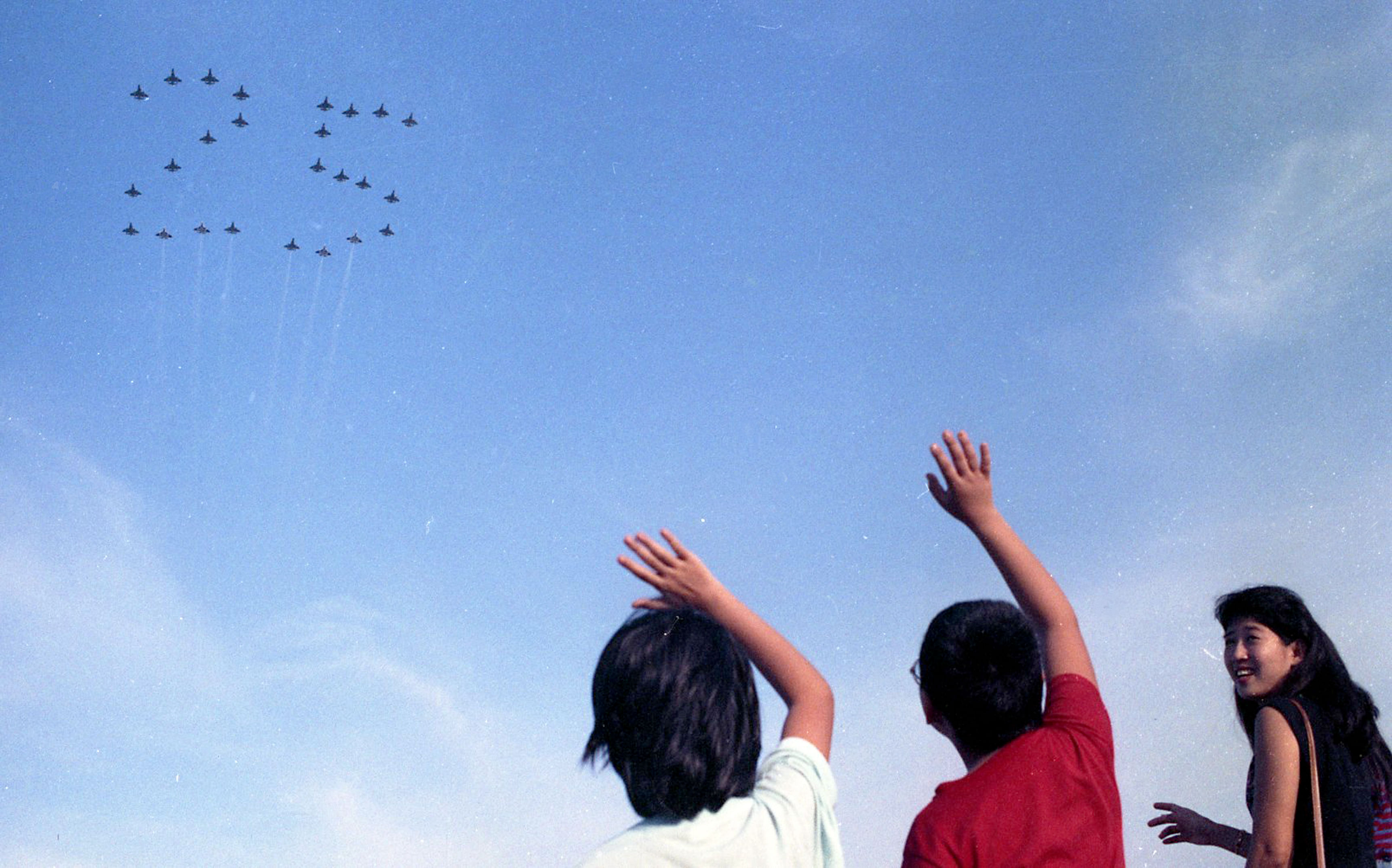
Singapore celebrates her 25th year of independence with the catchy song, One People, One Nation, One Singapore. The parade marks Mr Lee Kuan Yew's last year as Prime Minister of Singapore. It also sees a comeback of the military mobile column, made up of a record 250 vehicles.
1991
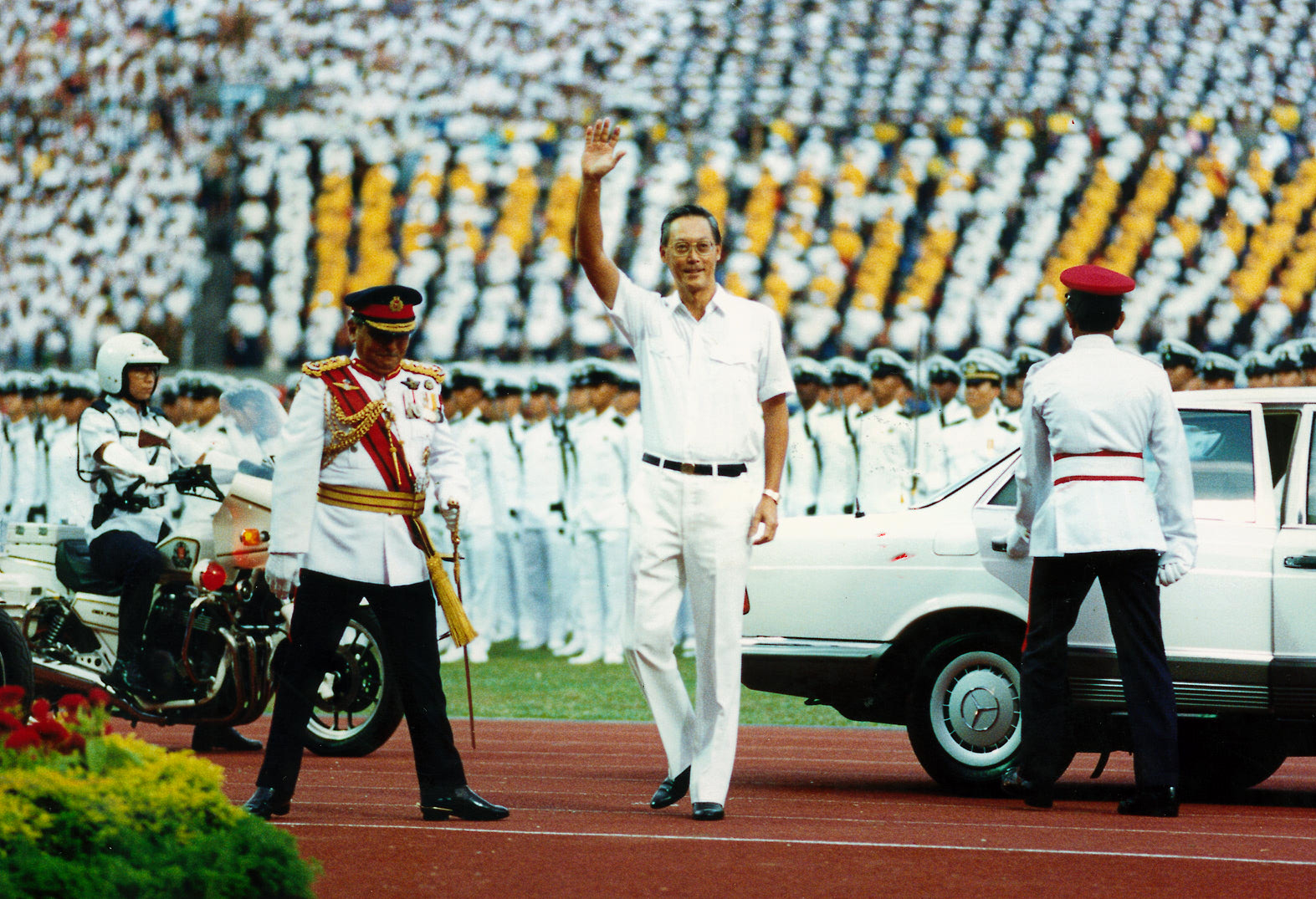
Mr Goh Chok Tong is greeted with loud applause at his first parade as Prime Minister. Commandos execute the highest Omega Descent from the National Stadium light towers - about 20 storeys high - and there is a heart-stopping moment when half of the Happy Birthday banner they release fails to unfurl. NDP funpacks are introduced.
1992
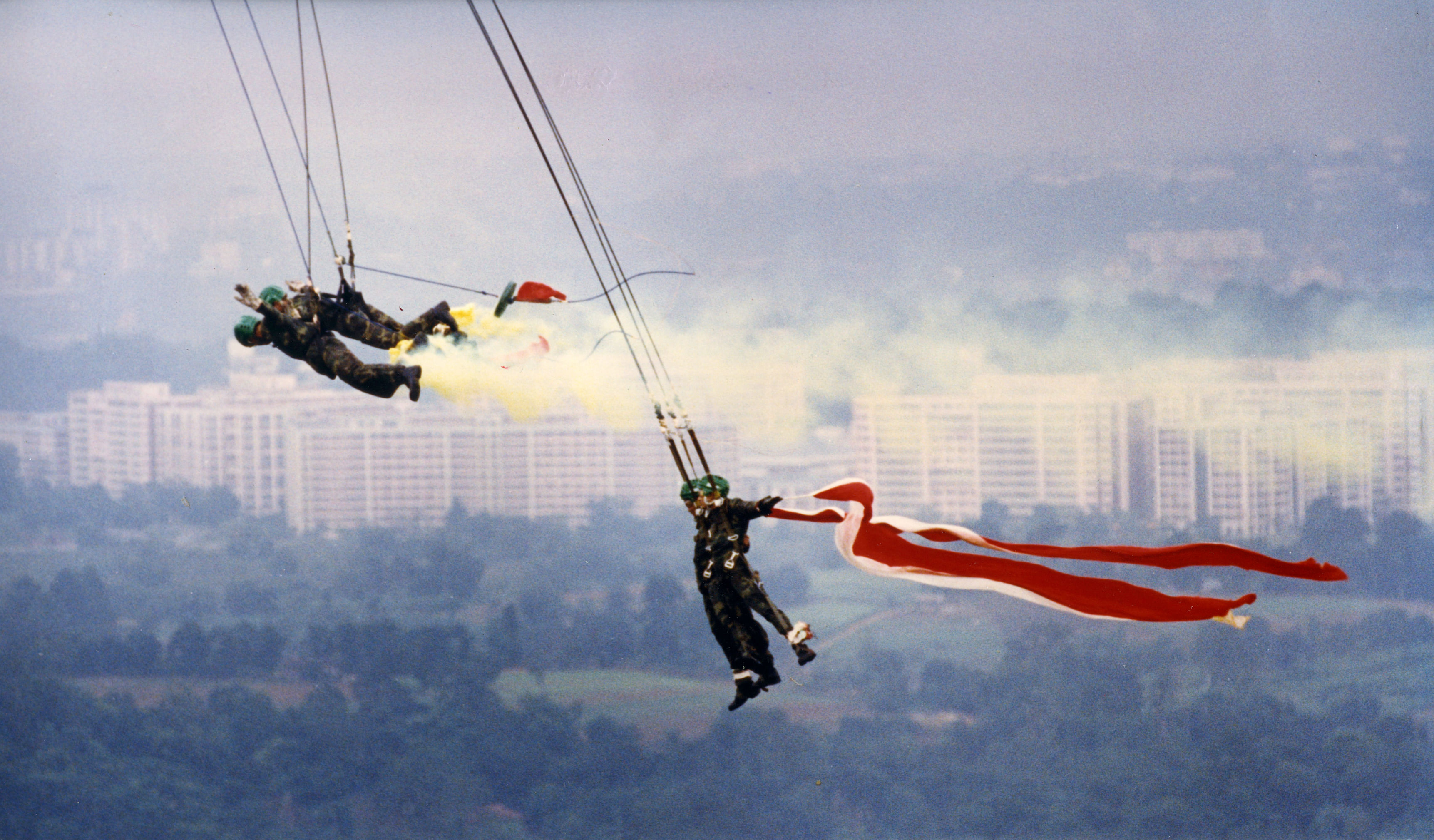
The parade is specially significant to the SAF as it is the 25th year of NS. National servicemen put on an impressive show using 64 physical training logs. Super Skyhawks execute a precision bomb burst manoeuvre and commandos hang mid-air from Super Puma copters.
1993
Mr Wee Kim Wee attends his last parade as President at the Padang, noting that he felt "not one but two lumps in (his) throat". He had just recuperated from two operations and stepped down the following month.
1994
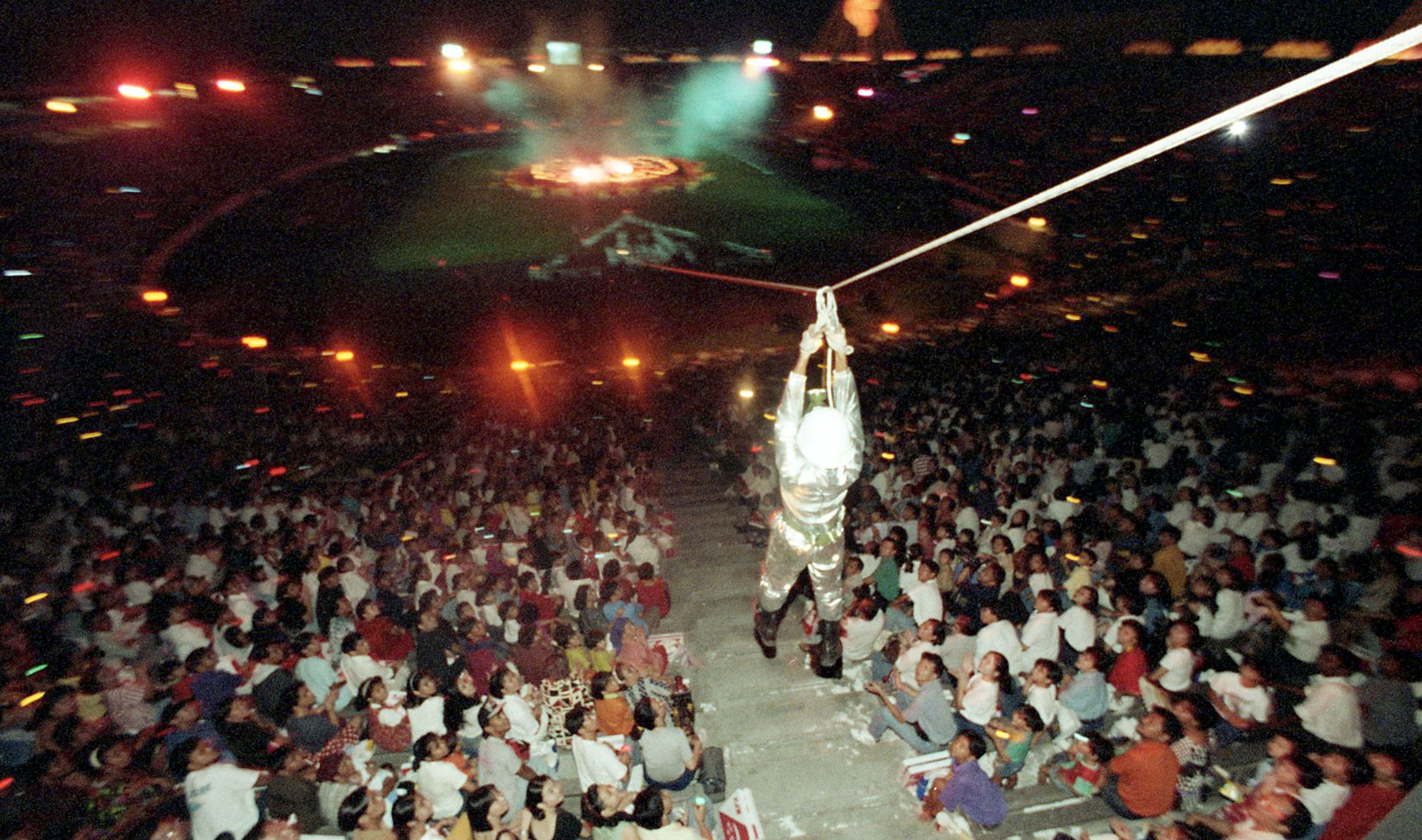
The first night parade, starting at 7.15pm, is Mr Ong Teng Cheong's first as President. It is also the first time the 25-pounder guns used for the traditional 21-gun Presidential Salute are placed inside the stadium. First mass display performance by the Singapore Civil Defence Force, with regulars swooping down via cables from the towers at the top of the gallery.
1995
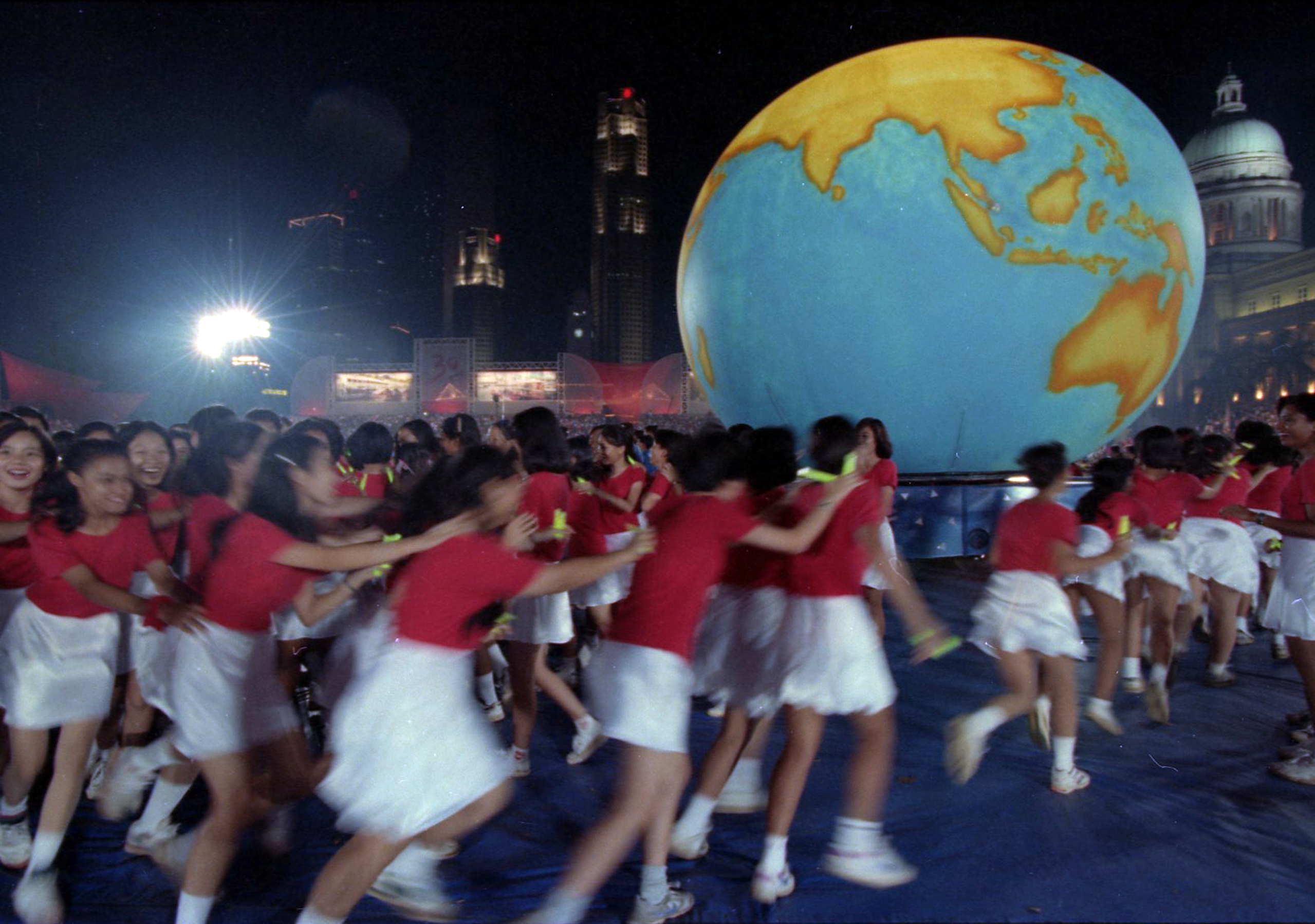
Singapore celebrates its 30th birthday at the Padang with the mobile column making an appearance after a five-year absence. The parade is a youth-oriented one.
1996
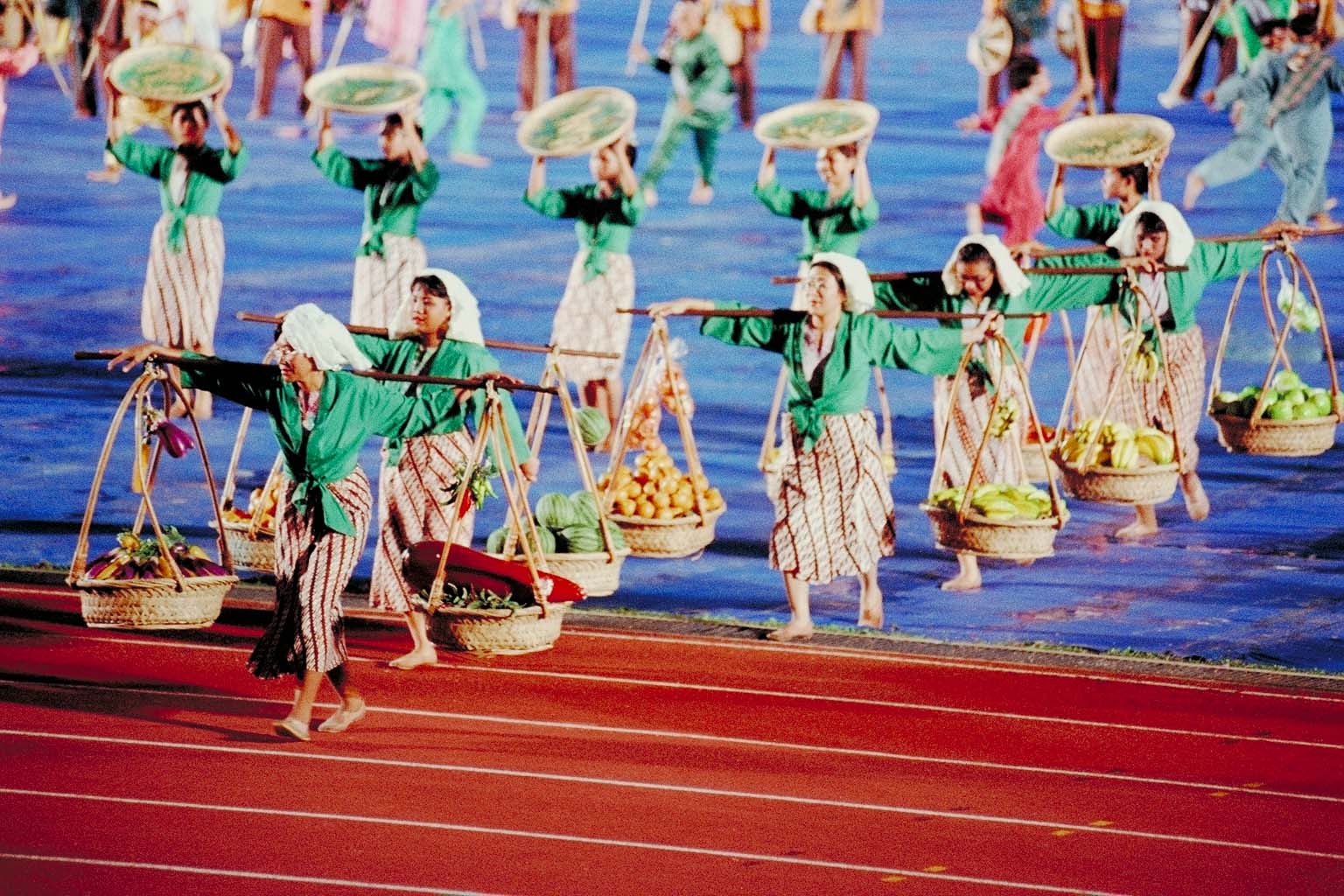
Poet Edwin Thumboo pens a drama on the story of Singapore for the parade. Almost two centuries of history unfold in 40 minutes at the National Stadium as a cast of 4,000 play out the Singapore Story.
1997
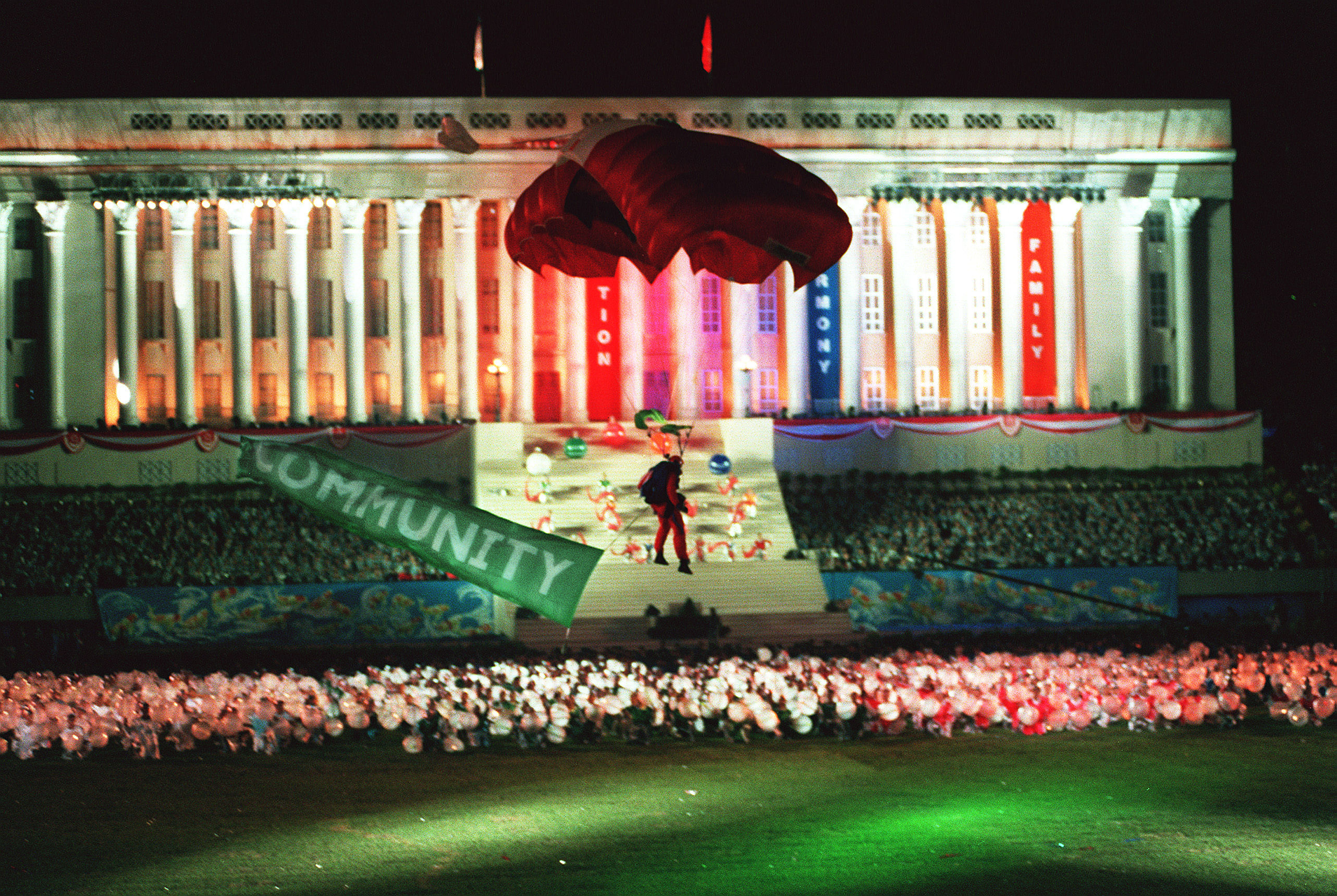
The Red Lions parachute into the National Stadium bearing the Asean flag and state flags of member countries for the first time. The centrepiece is a giant inflated rainbow which symbolises the pursuit of the Singapore dream. This is also the year that the National Education Show - for Primary 5 pupils - is launched.
1998
Kit Chan debuts the Dick Lee song Home, which becomes an instant favourite. Two parade venues are rolled into one with a replica of City Hall built at the National Stadium.
1999
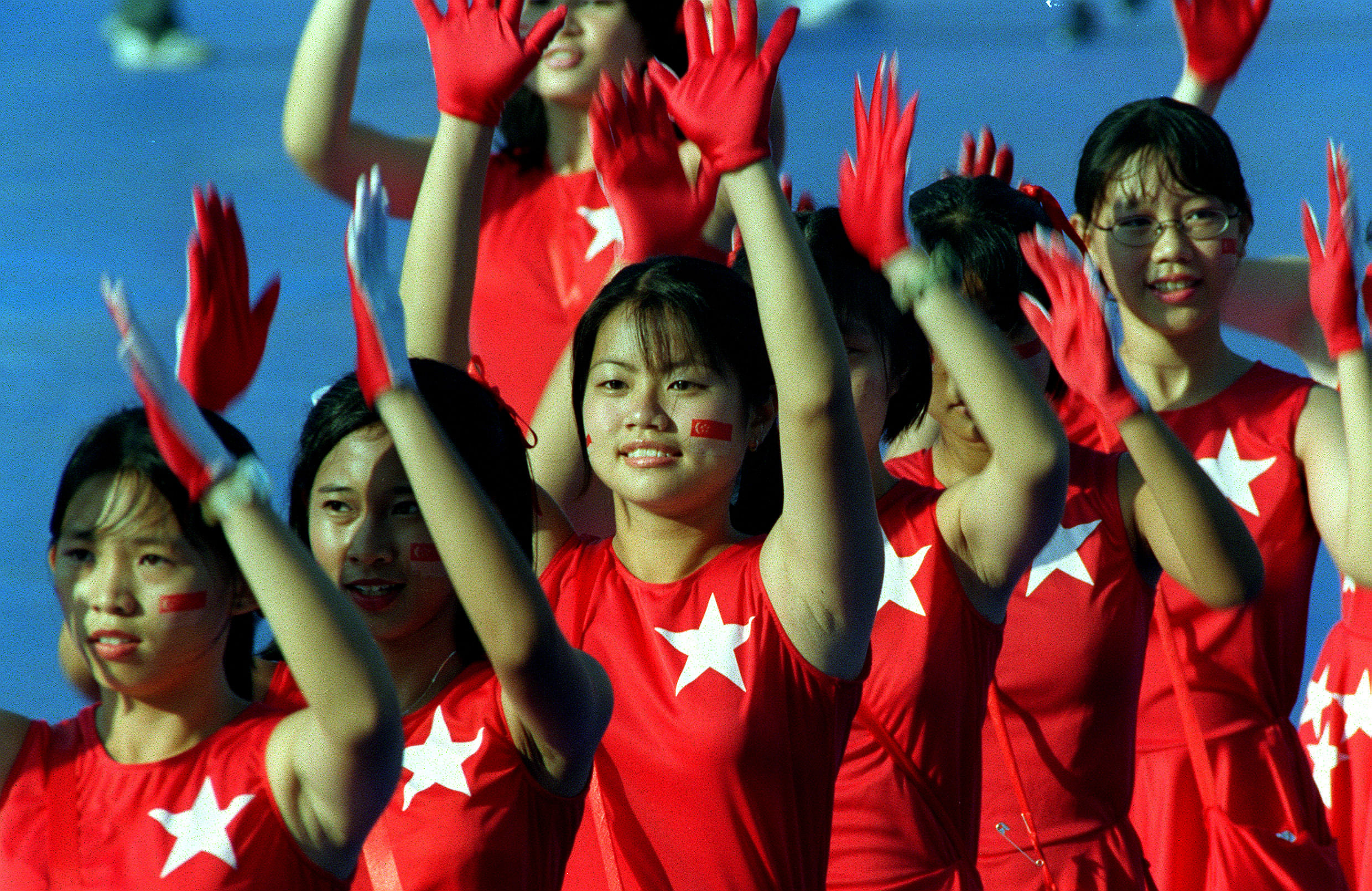
Overseas Singaporeans watch the parade live for the first time over the Internet. It is Mr Ong Teng Cheong's last parade as President. Parade committee chairman Brigadier-General Andrew Tan comes up with the NDP tattoo which has since become a National Day staple.
2000
The first National Day of the new millennium offers several firsts - a four-day carnival, the RSAF Fighting Falcons, a new submarine - and the return of the mobile column. It is also President S R Nathan's first parade as head of state.
2001
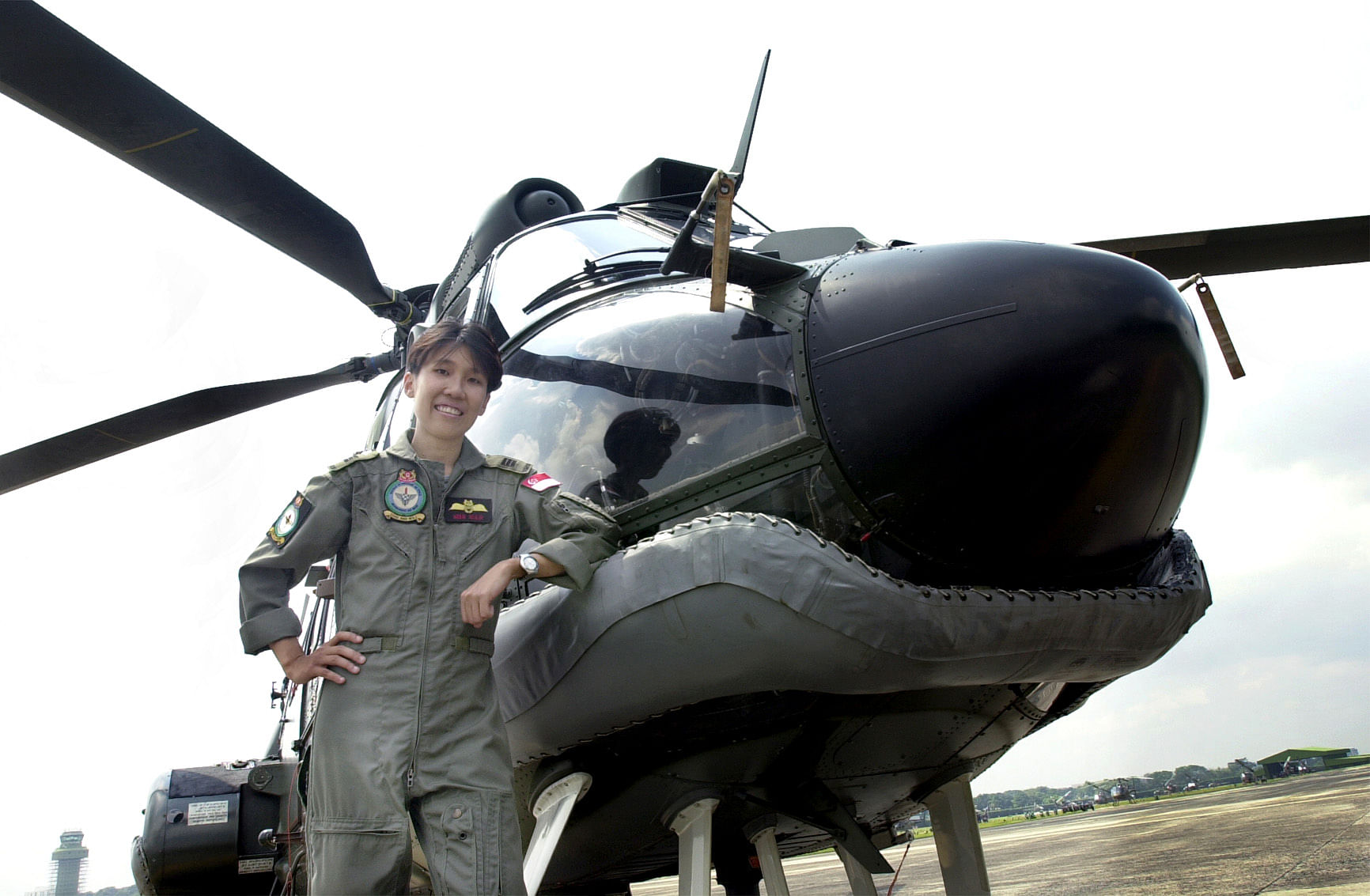
Captain Christine Sim (above) is the first woman to take part in the state-flag fly-past since 1970. A colourful 80m-long "bridge" connecting an island of people to a giant, glowing globe is the parade centrepiece at the National Stadium, while Tanya Chua sings the self-composed Where I Belong.
2002
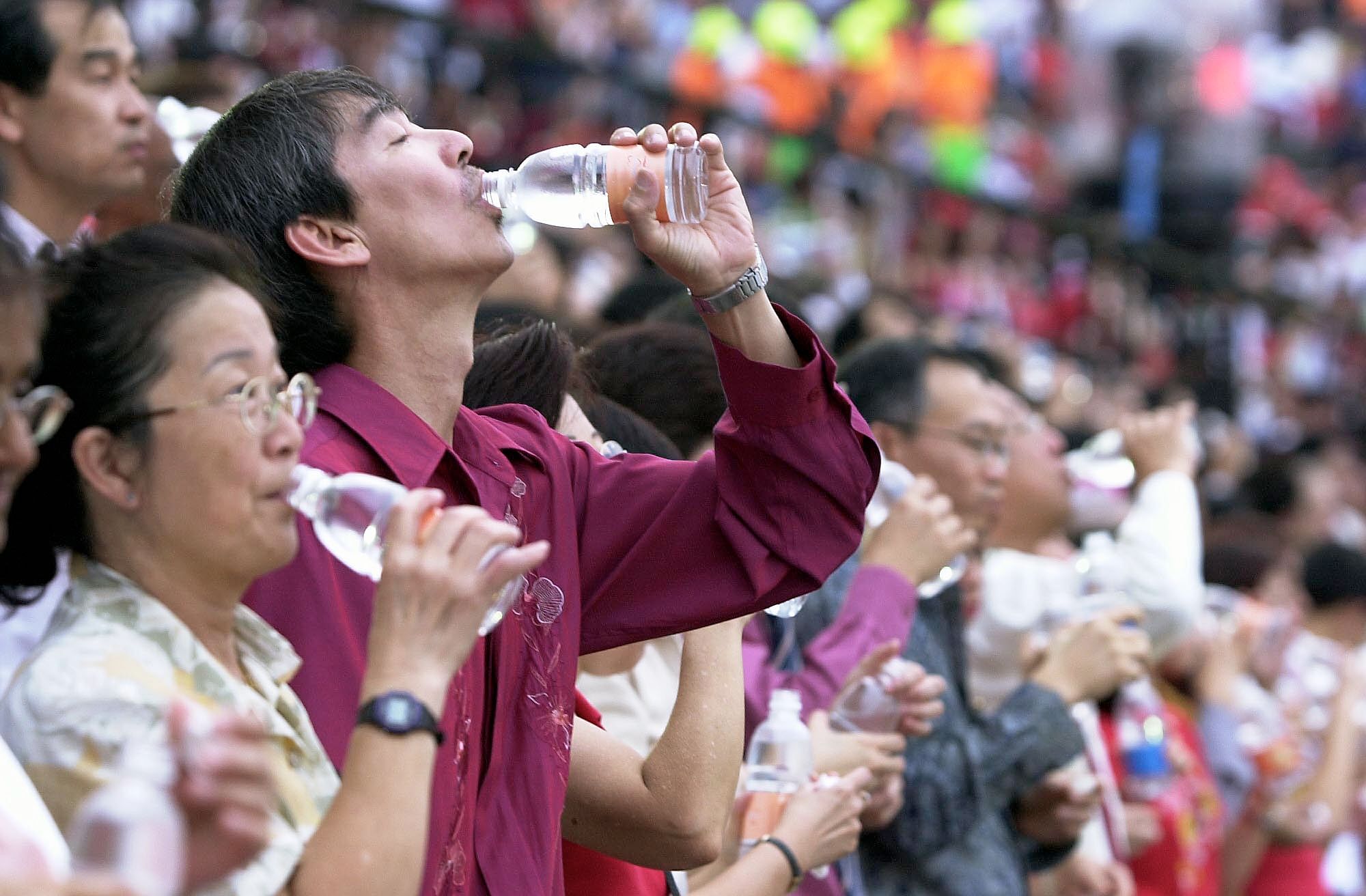
Coming out of an economic recession, Singapore's 37th birthday is celebrated with great joy. Parade-goers also get to sample the newly released Newater found in their funpacks.
2003
The parade takes place at the National Stadium just three months after the Sars outbreak kills 33 people in Singapore. The crowd pays tribute to 240 healthcare workers who enter the stadium bearing glowing hearts to the strains of a specially written song - Through Your Eyes.
2004
The 21/2-hour parade is capped with a surprise video tribute to Mr Goh Chok Tong, who would hand in his letter to the President the next morning to step down as Prime Minister. He gets a standing ovation from the crowd.
2005
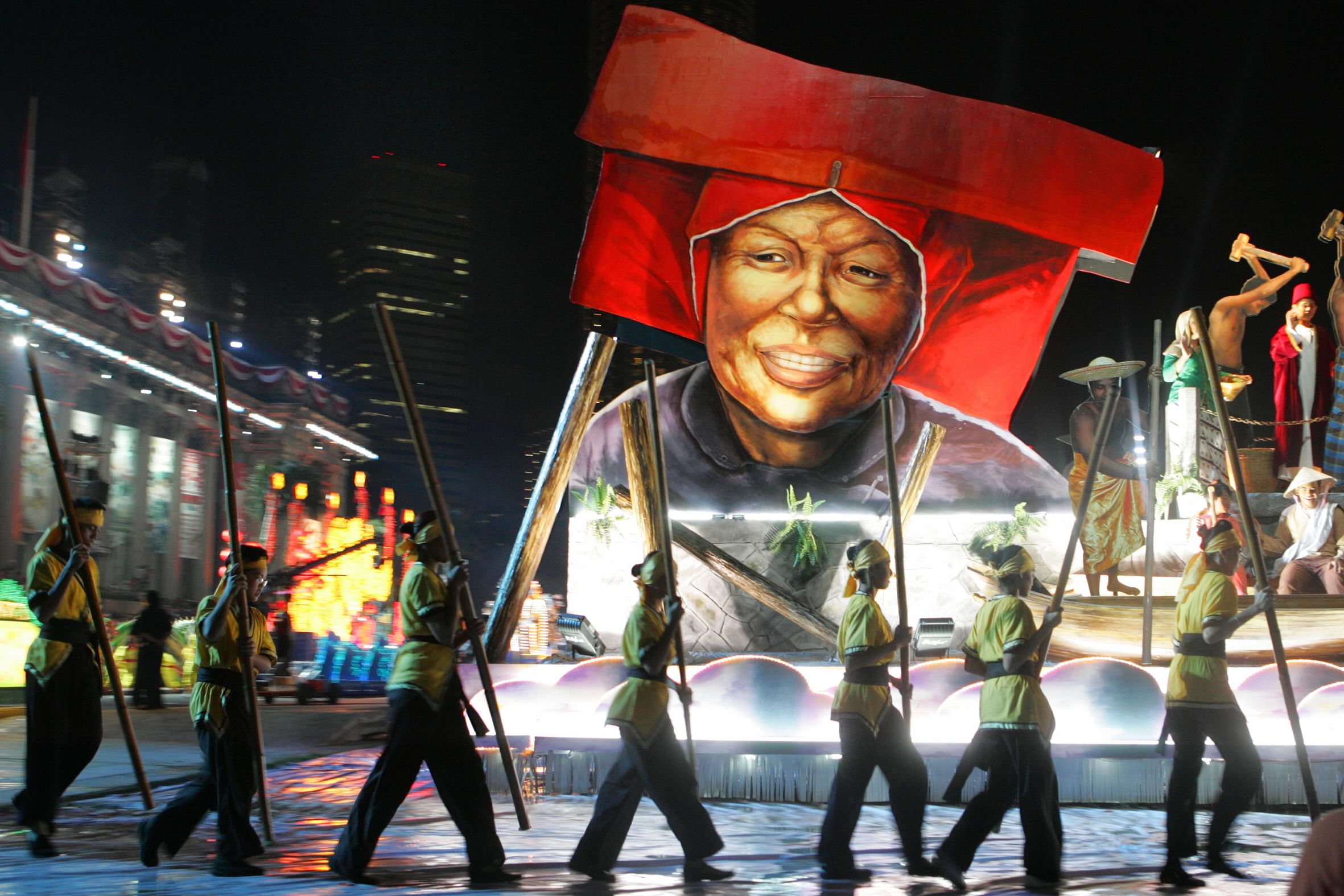
Singapore celebrates its 40th birthday with simultaneous parties at five locations - a main parade at the Padang and four other celebrations in Marina South, Tampines, Yishun and Jurong East. All are linked by a live feed. This is Mr Lee Hsien Loong's first parade as Prime Minister.
Above: One of 12 floats depicting aspects of Singapore's history trundling by the Padang.
2006
The National Stadium hosts the parade for the last time before being torn down. The crowd pays tribute to former deputy prime minister S. Rajaratnam, who died in February, reciting the Pledge which he wrote.
2007
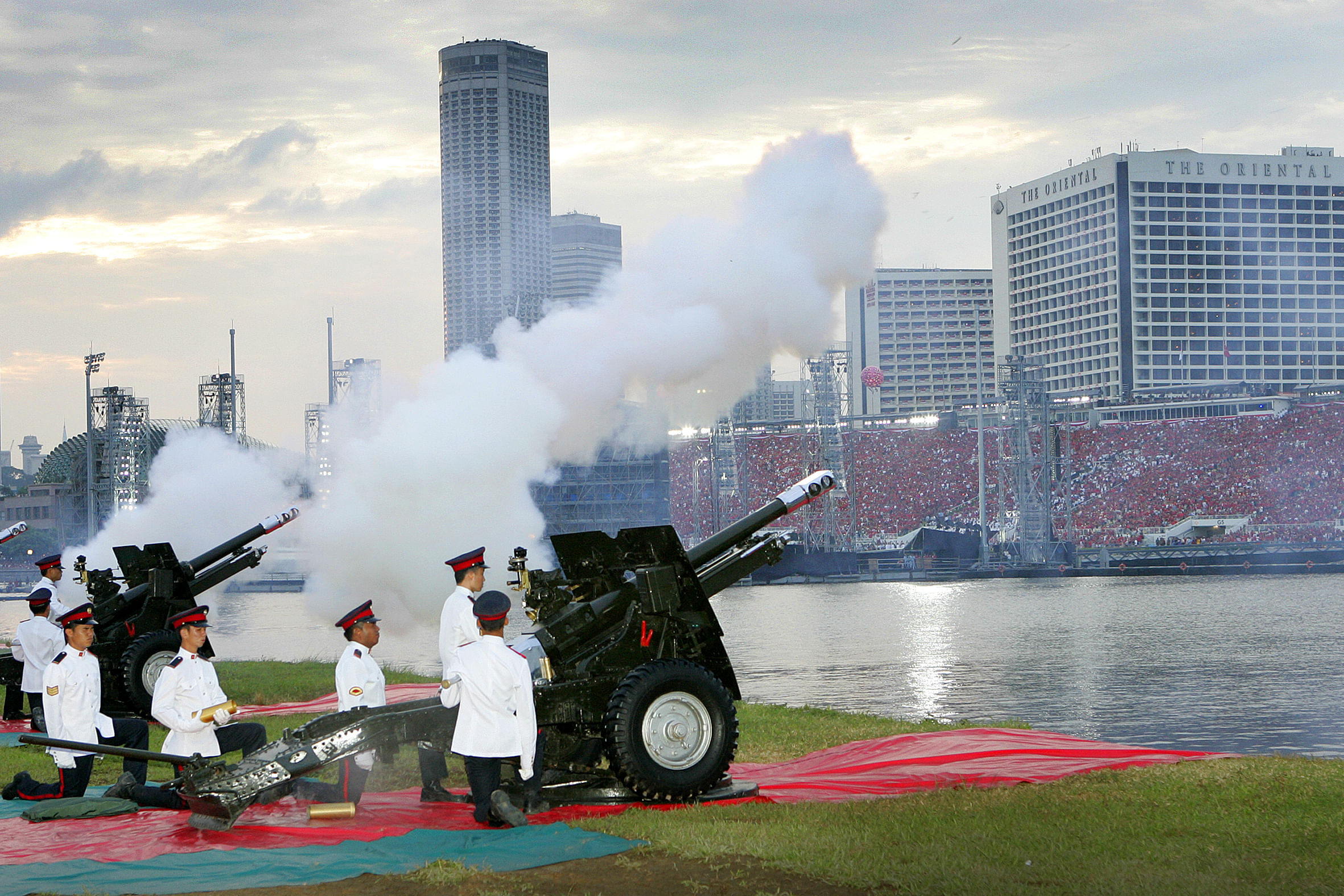
The first parade on the Marina Bay floating platform (above) gets the thumbs up, with many praising the waterfront ambience.
2008
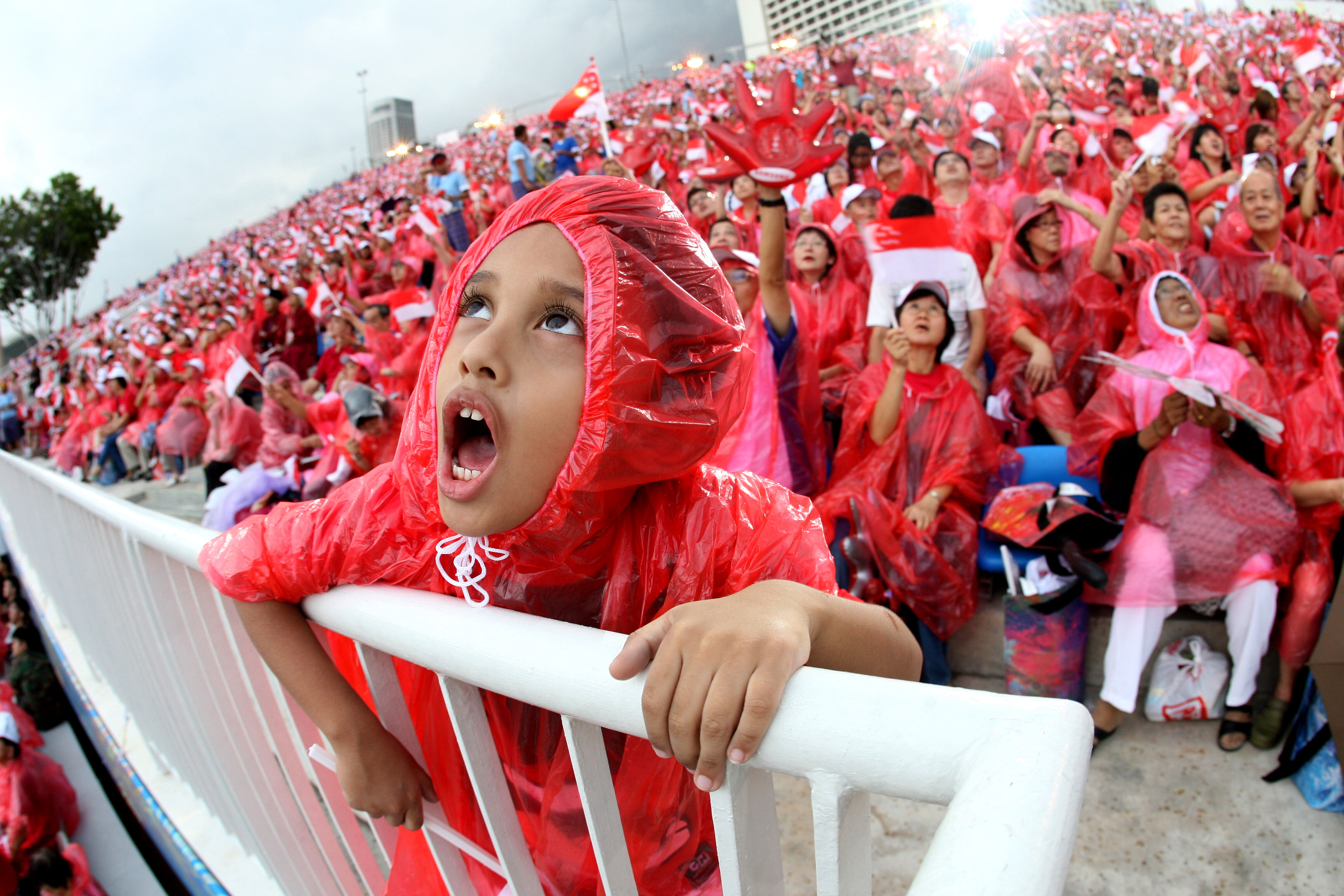
It is a wet parade but spirits are hardly dampened as parade-goers put their funpack ponchos to good use.
2009
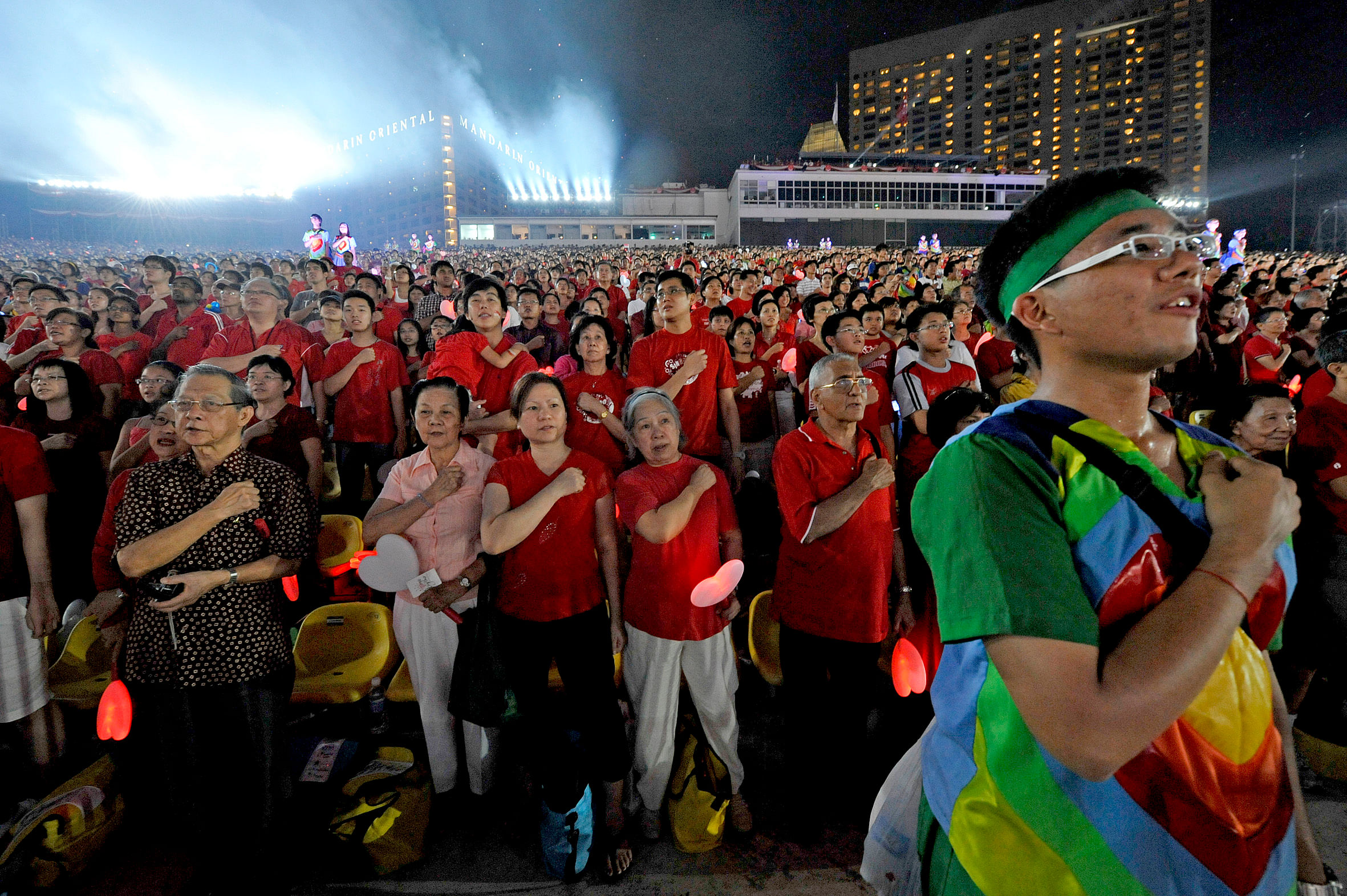
At 8.22pm, SCDF sirens sound across the island and Singaporeans - including thousands overseas - recite the Pledge.
2010
The parade returns to the Padang. Singer Kit Chan belts out Home and Singaporeans follow with a "One Voice" moment, reciting the Pledge and singing the National Anthem. The parade is also celebrated at five heartland locations.
2011
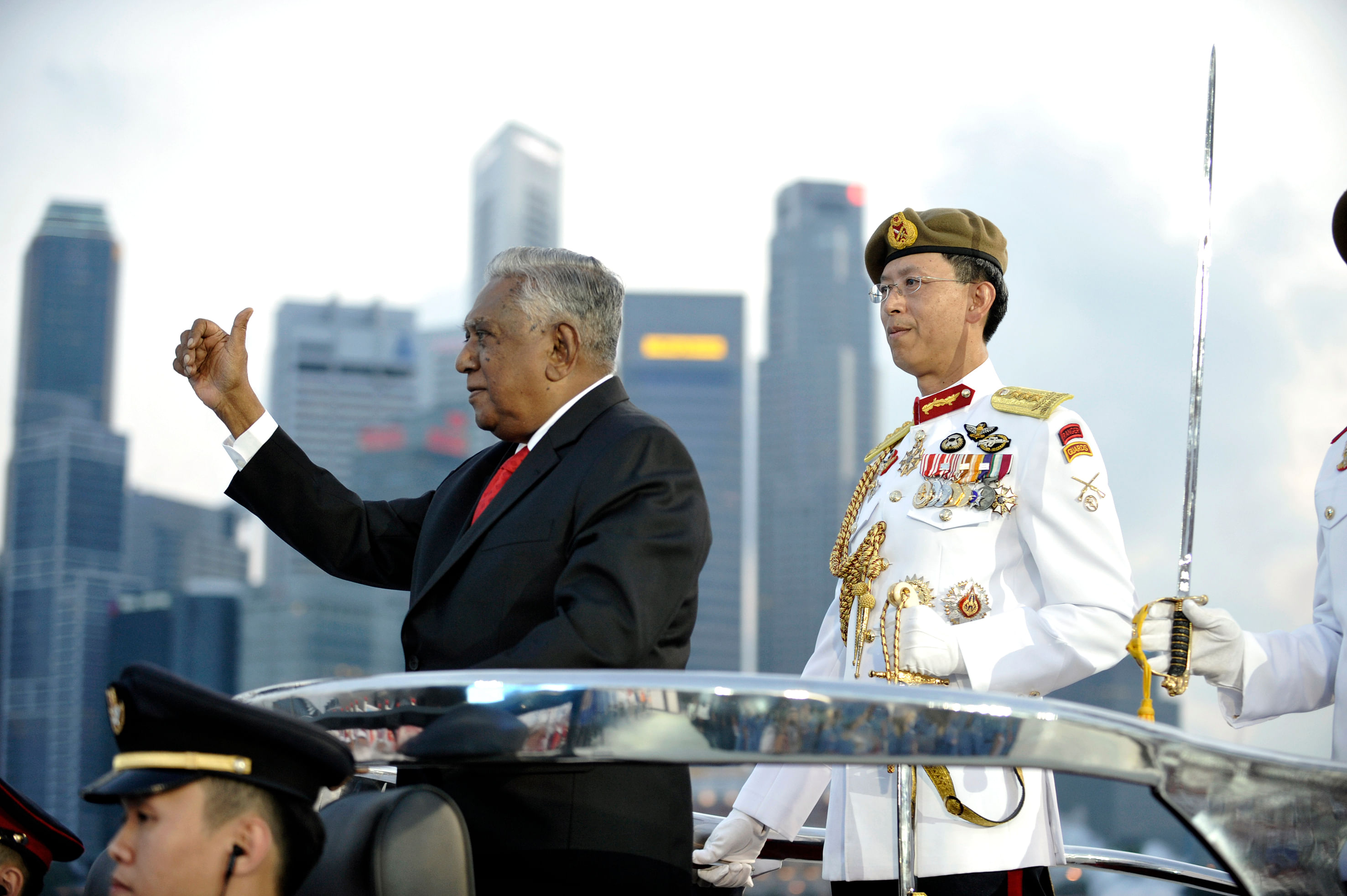
This year marks the final NDP for President S R Nathan as head of state. It is the first time the parade - at the Floating Platform - is held against a completed Marina Bay skyline. It is also the first time former prime ministers Lee Kuan Yew and Goh Chok Tong do not have front-row seats. Both have retired from Cabinet and are seated behind with the MPs. The parade also gets its first female regimental sergeant major - Master Warrant Officer Jennifer Tan.
2012
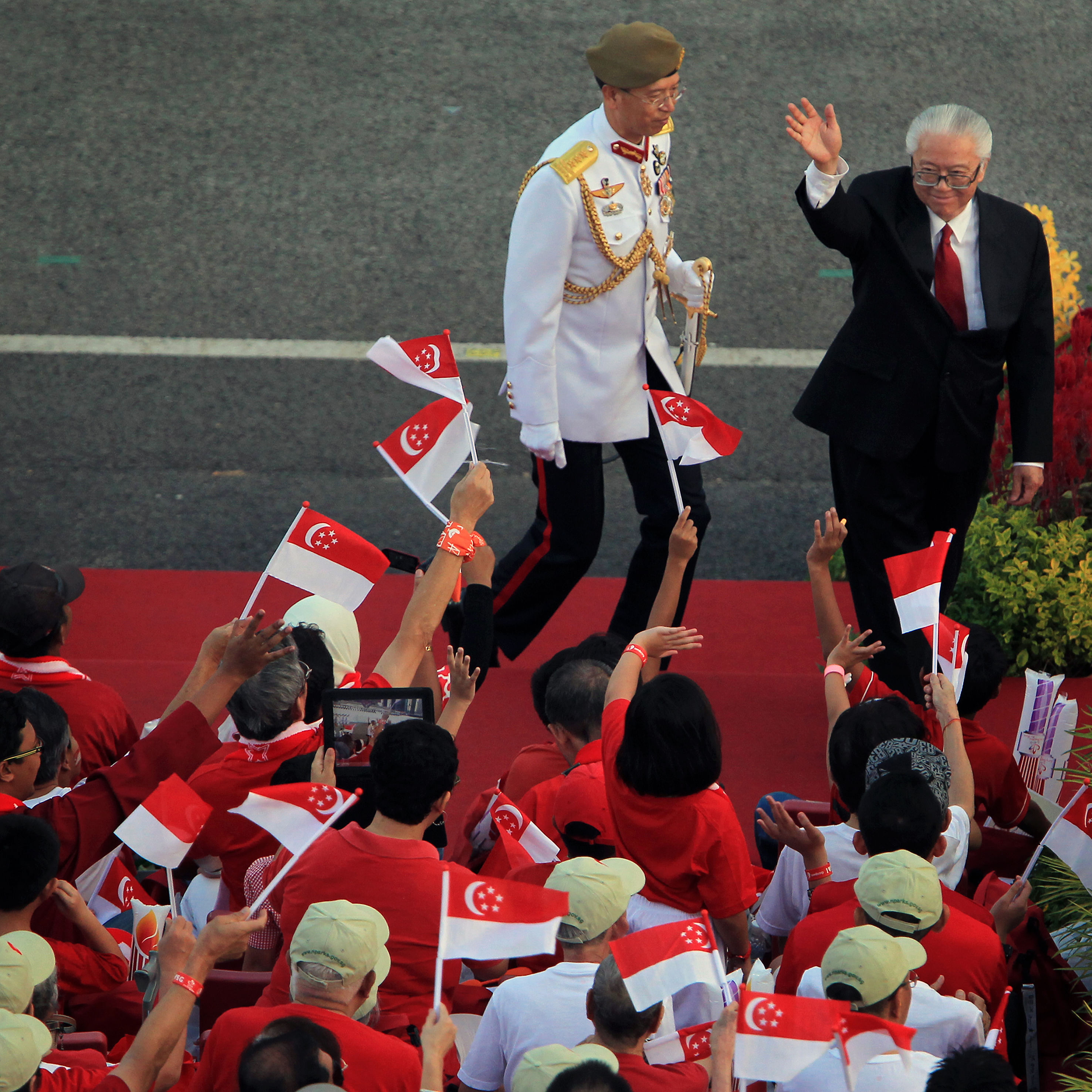
Singapore celebrates its 47th birthday with an Olympic win at the ongoing London Games. President Tony Tan Keng Yam observes his inaugural parade as head of state and MPs show up in red and white for the first time, instead of the usual all-white for the People's Action Party and blue for the Workers' Party.
2013
Third Warrant Officer Shirley Ng is denied the chance to make history as the first woman to skydive onto the parade floor as part of the annual Red Lions parachuting display after cloudy conditions force the team to cancel its appearance at the Floating Platform.
2014
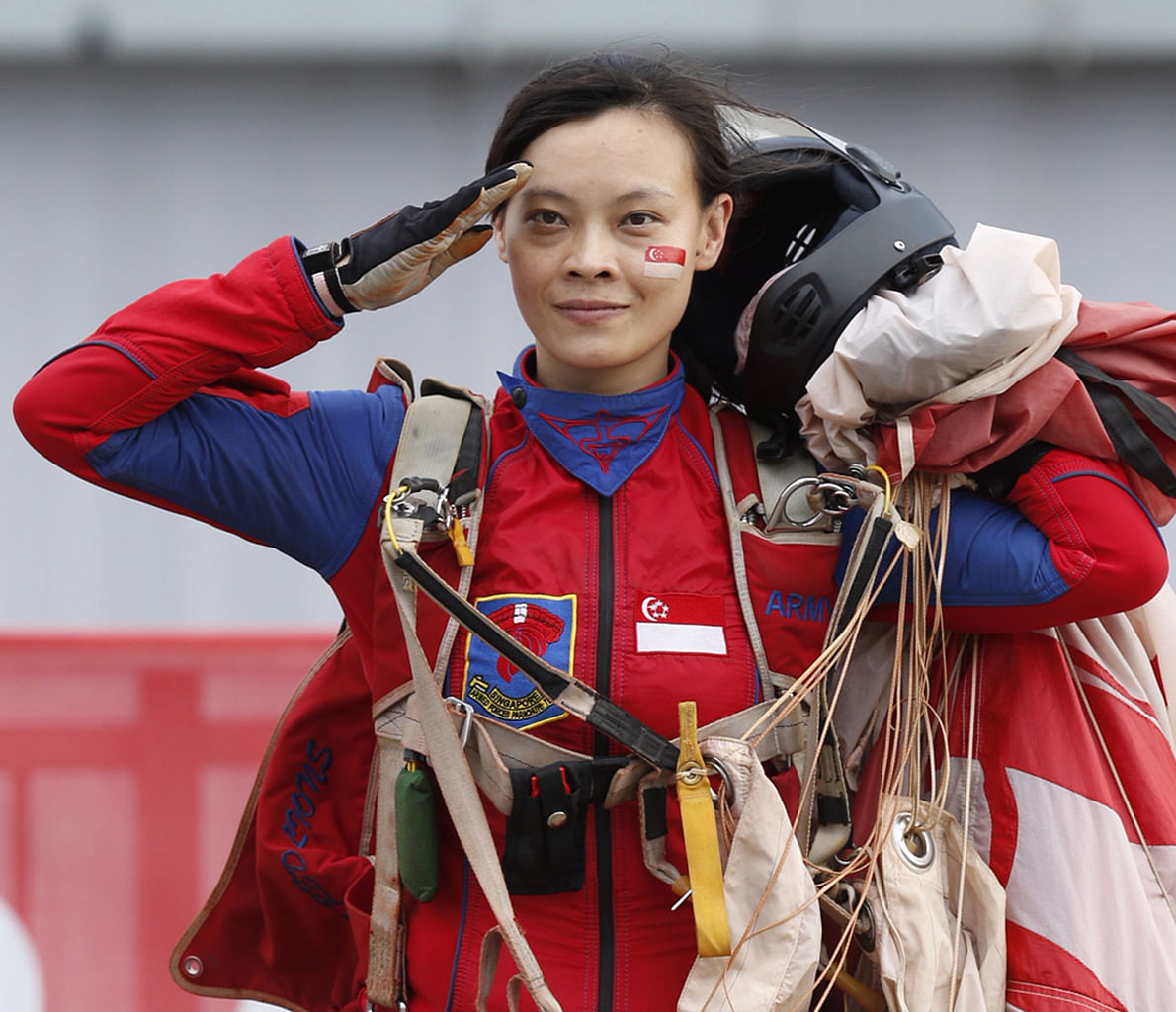
Third Warrant Officer Shirley Ng becomes the first female Red Lion parachutist to perform at an NDP celebration.
2015
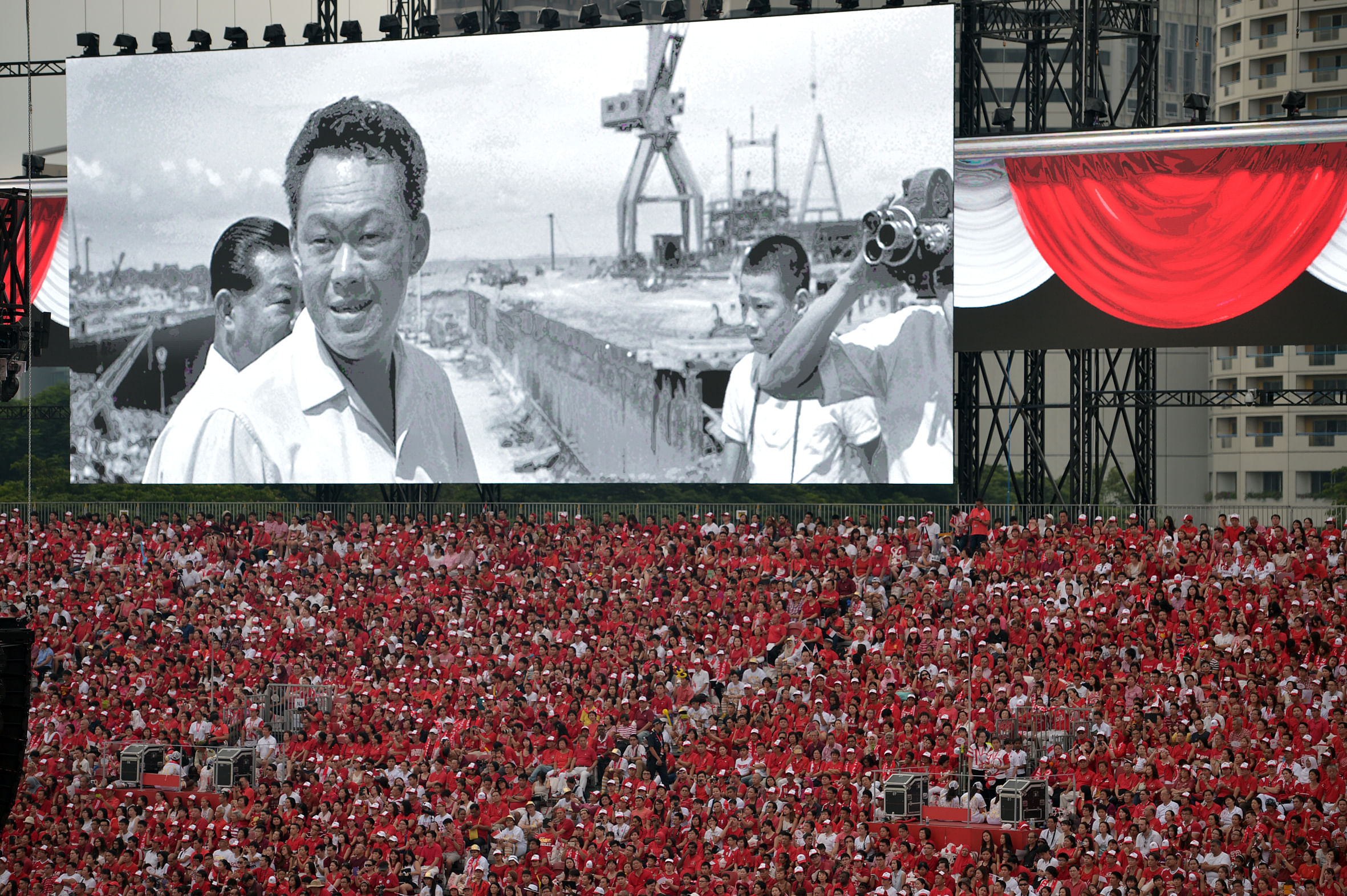
Singapore's 50th birthday is celebrated with gusto at the Padang, but there are also reflective moments as founding father Lee Kuan Yew, who died in March, is remembered in a video segment. Earlier in the day, public warning sirens herald the broadcast of a recording of Mr Lee reading the Proclamation of Singapore.
2016
The parade will be held today for the first time at the Sports Hub with indoor fireworks, aerial performers and a flying unicorn to wow the crowd. The show also goes high-tech - giant props will be brought to life using 3D projection mapping, while the funpack will include a souvenir booklet that can activate a free augmented reality app.

